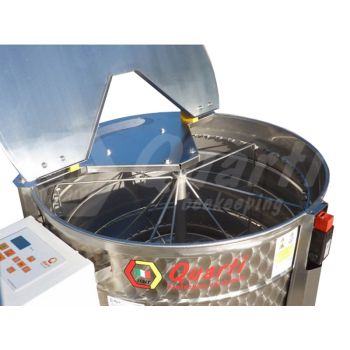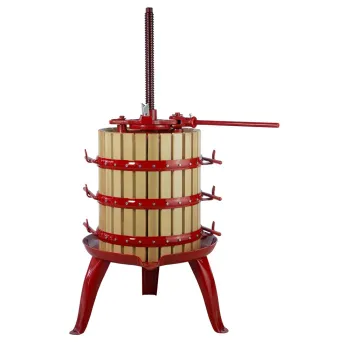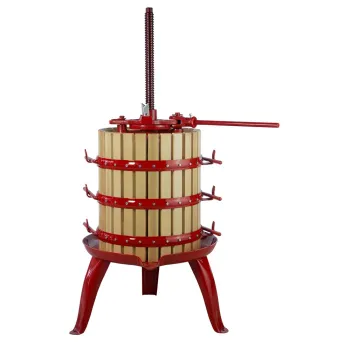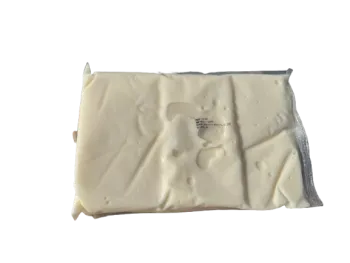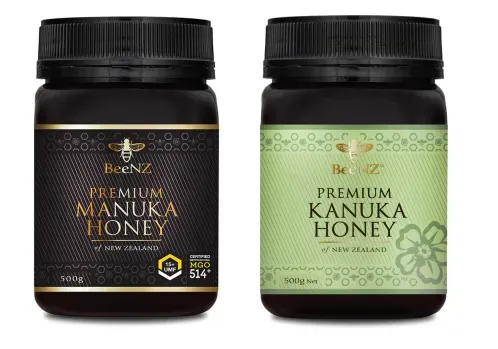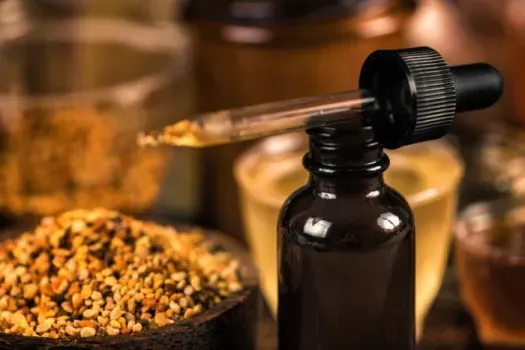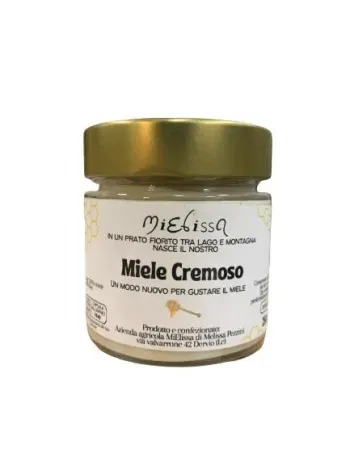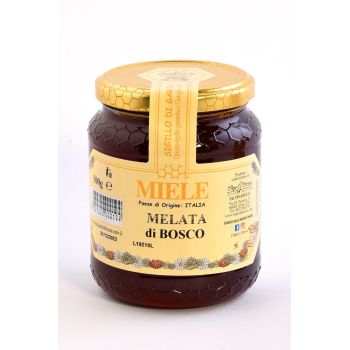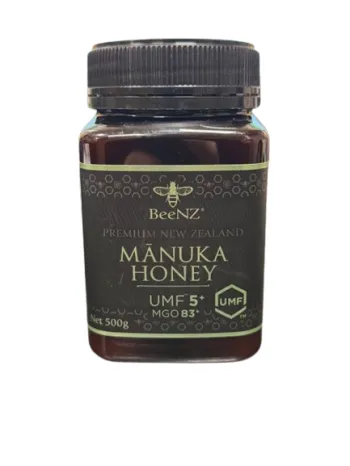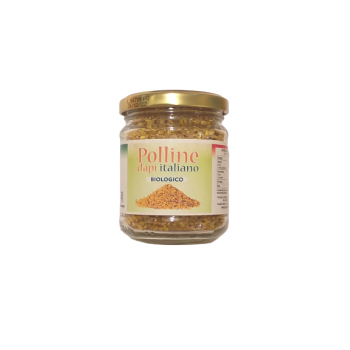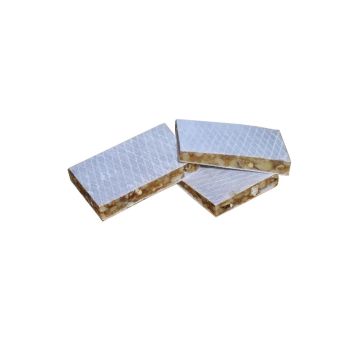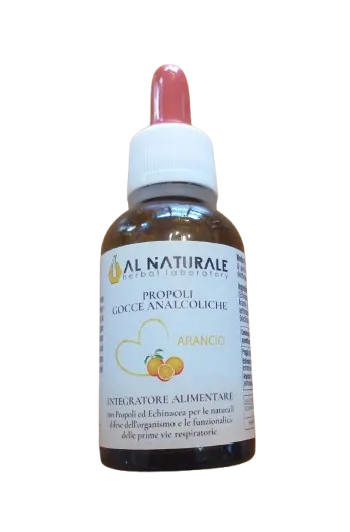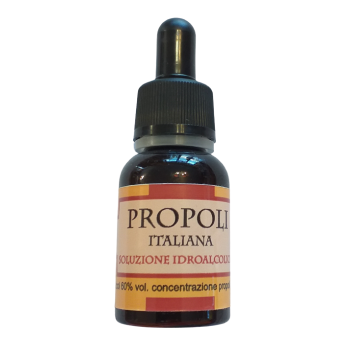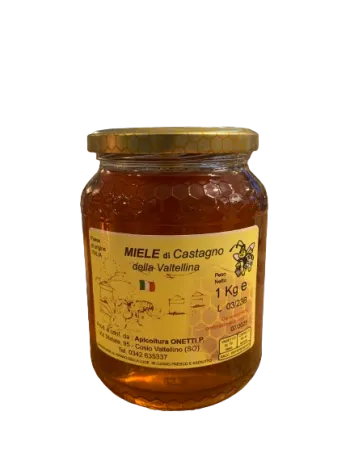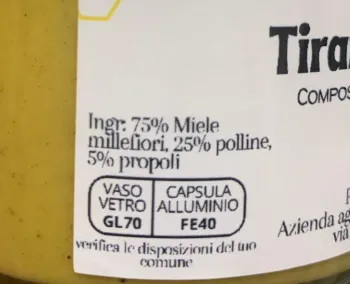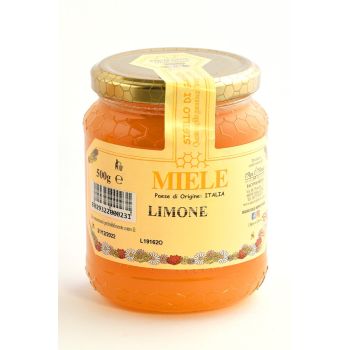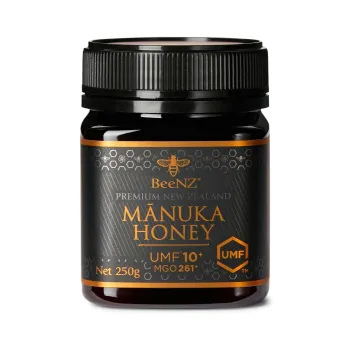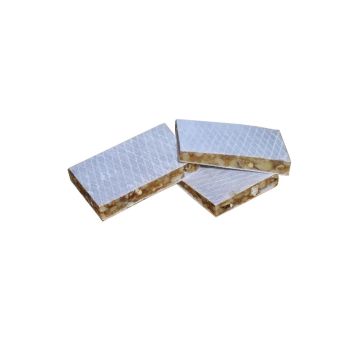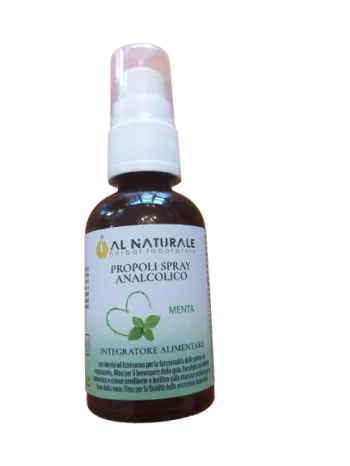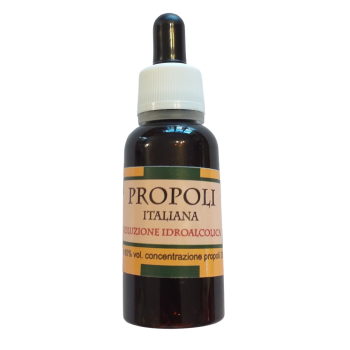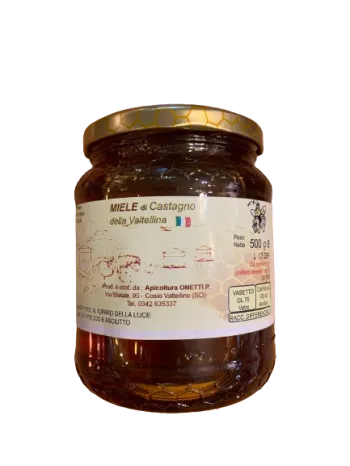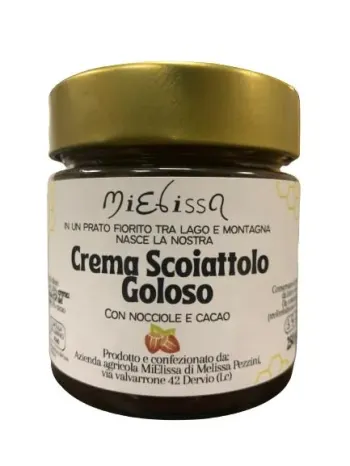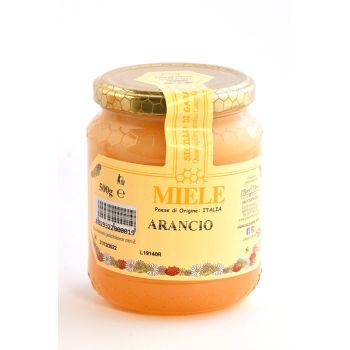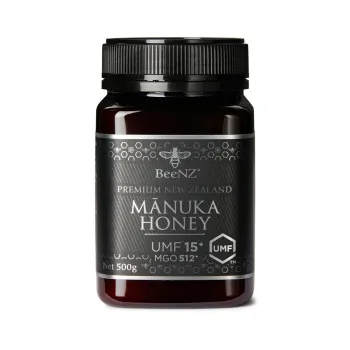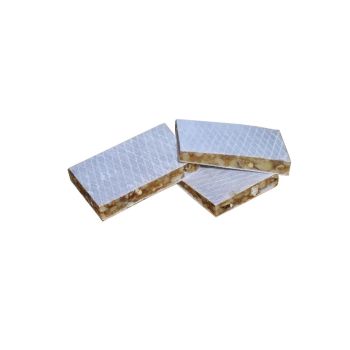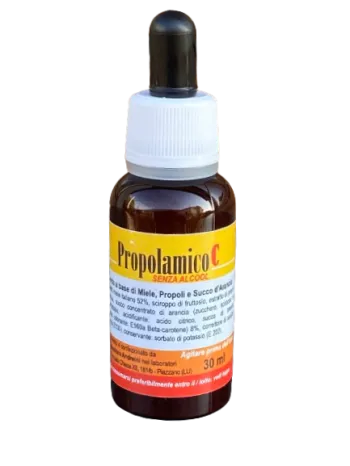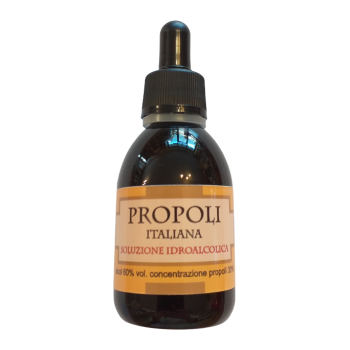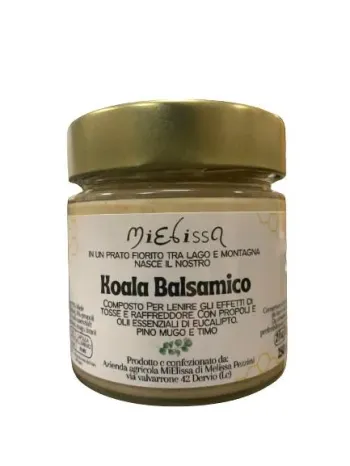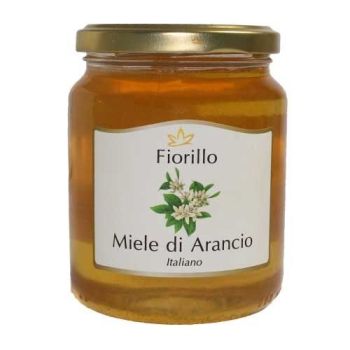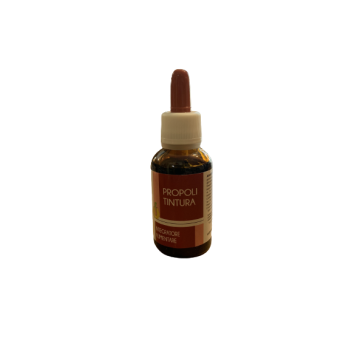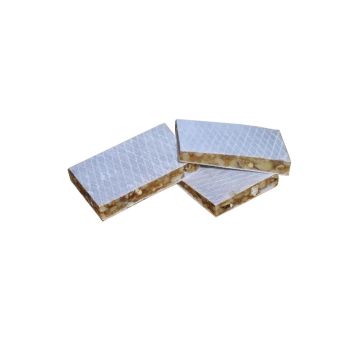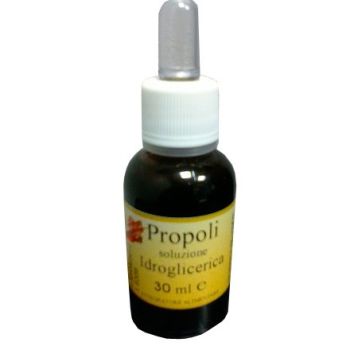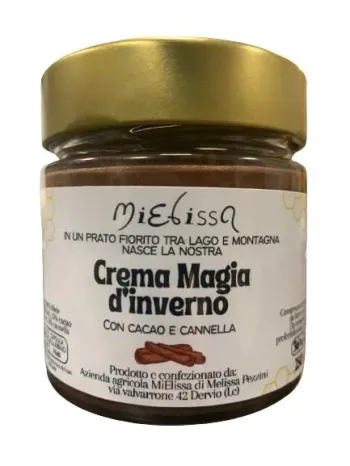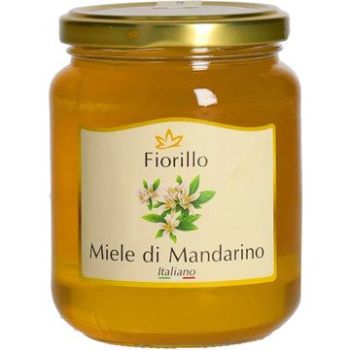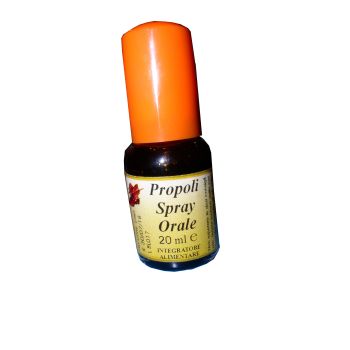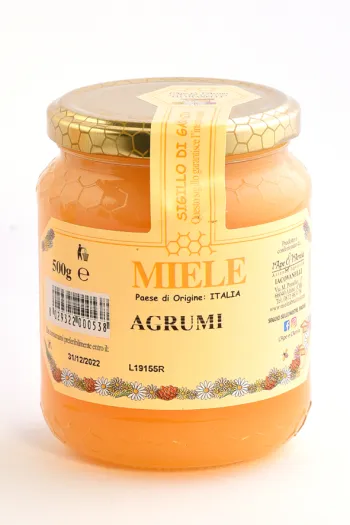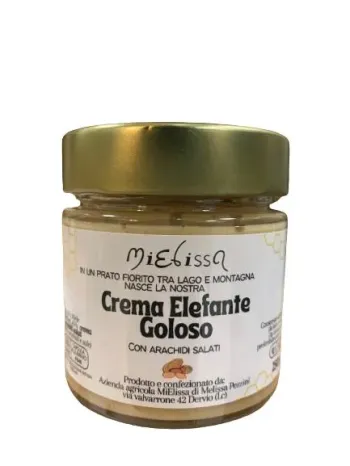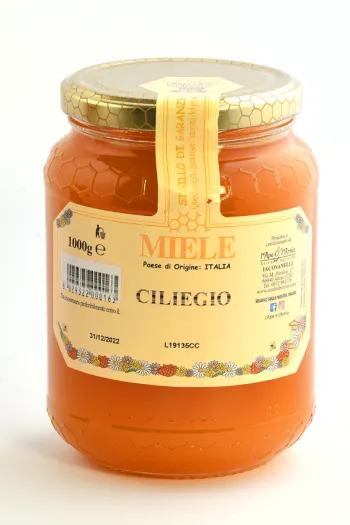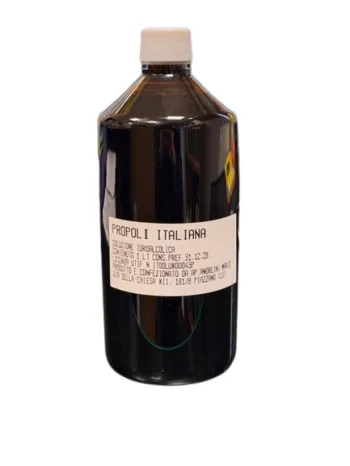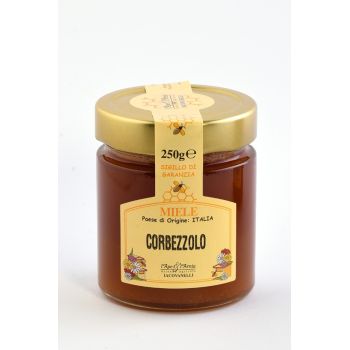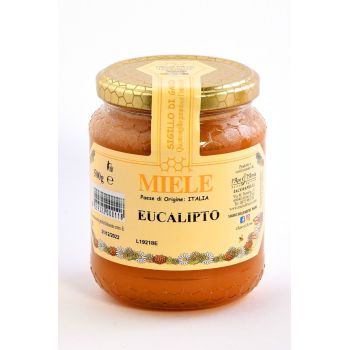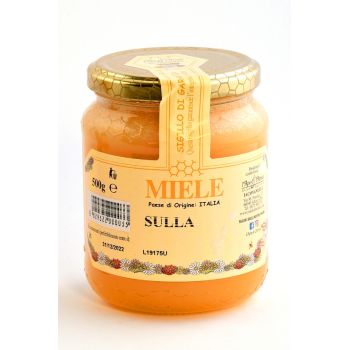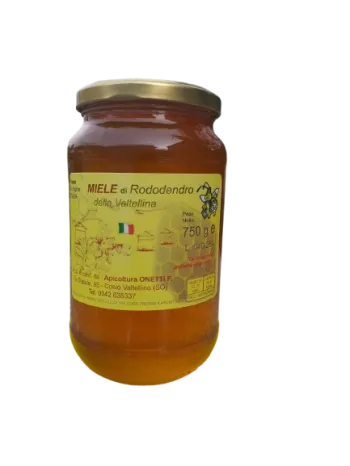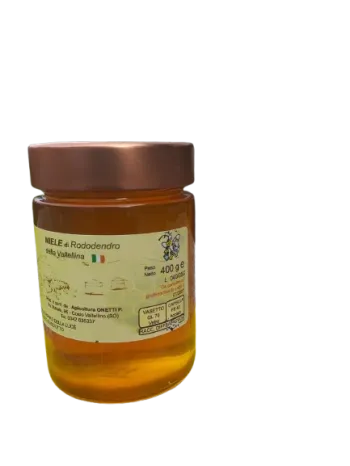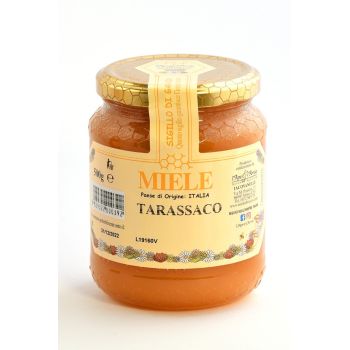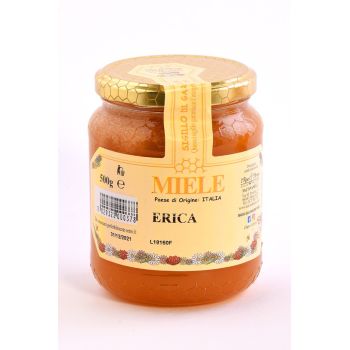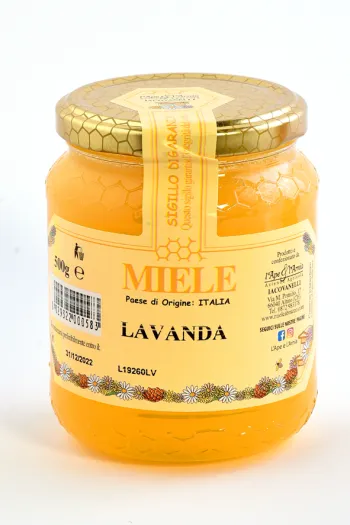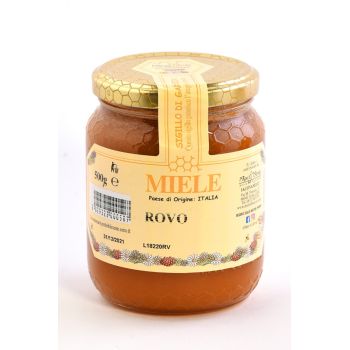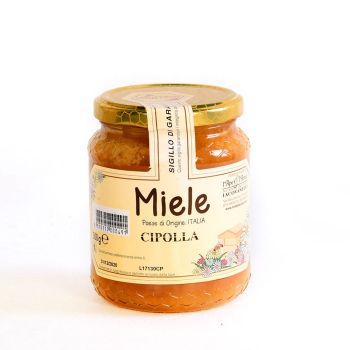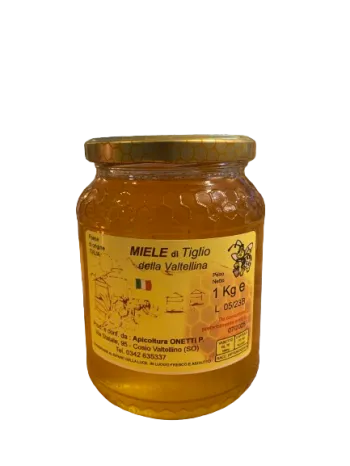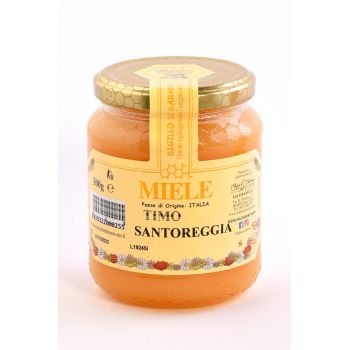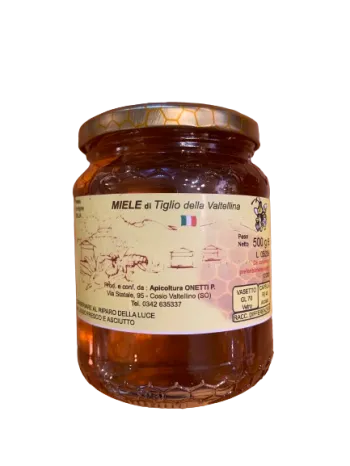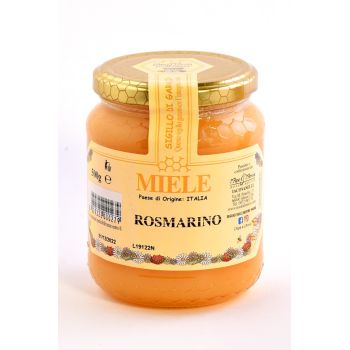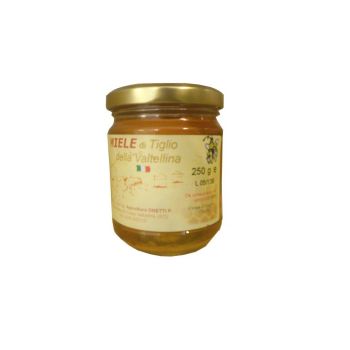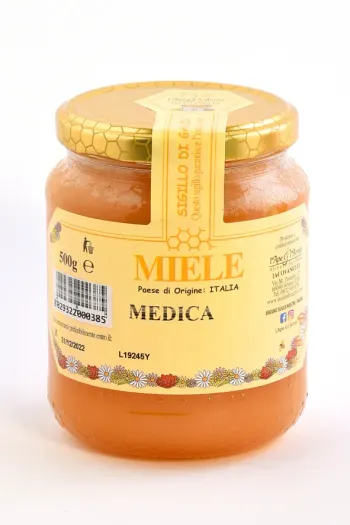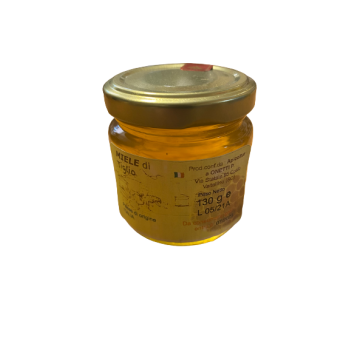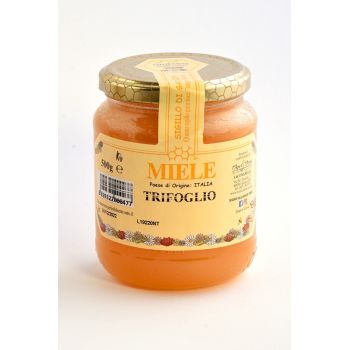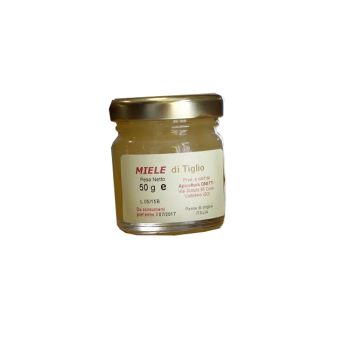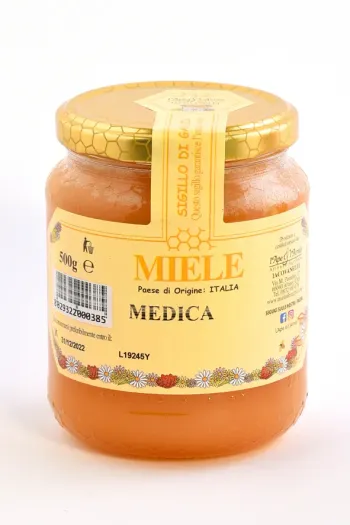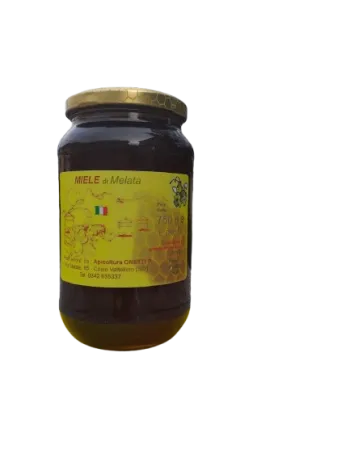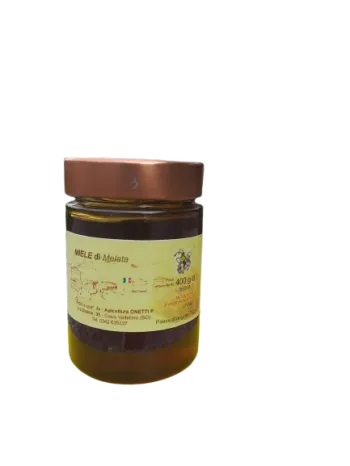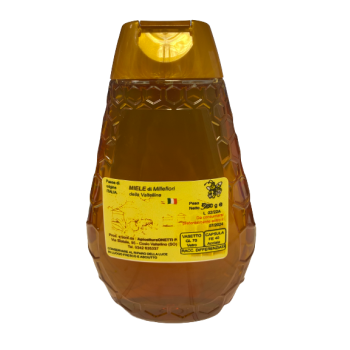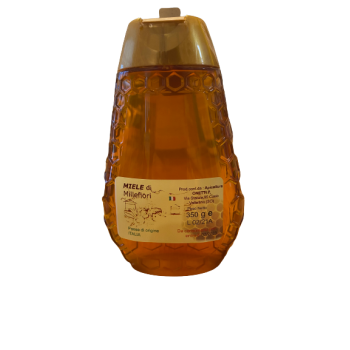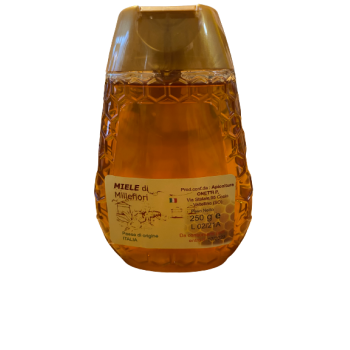Miel natural y otros productos de la colmena
La miel se procesa para romper los cristales y detener la cristalización. Este método mantiene intactas las propiedades de la miel y la hace cremosa, untable y no "pegajosa".
La miel se procesa para romper los cristales y detener la cristalización. Este método mantiene intactas las propiedades de la miel y la hace cremosa, untable y no "pegajosa".
Miel de mil flores procesada durante 48 horas por una máquina que la hace espumosa y untable. Peso 250 g o 400 g Extraída, preparada y envasada en frío. MIEL ITALIANA producida en la zona de Orobic - Lombardía
Miel de mil flores procesada durante 48 horas por una máquina que la hace espumosa y untable. Peso 250 g o 400 g Extraída, preparada y envasada en frío. MIEL ITALIANA producida en la zona de Orobic - Lombardía
Miel de mil flores procesada durante 48 horas por una máquina que la hace espumosa y untable. Peso 250 g o 400 g Extraída, preparada y envasada en frío. MIEL ITALIANA producida en la zona de Orobic - Lombardía
El melazo es la única miel que no es de origen floral; de hecho, toma su nombre de la Metcalfa pruinosa (un insecto) que, alimentándose de la savia de las plantas, expulsa la parte azucarada que luego recogen las abejas. La miel permanece líquida durante mucho tiempo, presentando un color oscuro que tiende al negro. El olor tiene notas vegetales y afrutadas, de fruta cocida, mientras que el sabor es poco dulce, de intensidad media y recuerda a la melaza, los dátiles o la mermelada de higos. Envasado en tarros de 500 g o 1 kg
El melazo es la única miel que no es de origen floral; de hecho, toma su nombre de la Metcalfa pruinosa (un insecto) que, alimentándose de la savia de las plantas, expulsa la parte azucarada que luego recogen las abejas. La miel permanece líquida durante mucho tiempo, presentando un color oscuro que tiende al negro. El olor tiene notas vegetales y afrutadas, de fruta cocida, mientras que el sabor es poco dulce, de intensidad media y recuerda a la melaza, los dátiles o la mermelada de higos. Envasado en tarros de 500 g o 1 kg
El melazo es la única miel que no es de origen floral; de hecho, toma su nombre de la Metcalfa pruinosa (un insecto) que, alimentándose de la savia de las plantas, expulsa la parte azucarada que luego recogen las abejas. La miel permanece líquida durante mucho tiempo, presentando un color oscuro que tiende al negro. El olor tiene notas vegetales y afrutadas, de fruta cocida, mientras que el sabor es poco dulce, de intensidad media y recuerda a la melaza, los dátiles o la mermelada de higos. Envasado en tarros de 500 g o 1 kg
Manuka UMF® honey from New Zealand has become one of the most sought-after floral honeys, recognized internationally for its unique antimicrobial properties.Manuka honey is indeed unique in that it contains antimicrobial compounds that are not found in any other floral honey. This uniqueness has led to the development of a testing regimen to certify the concentration of these compounds known as the "unique manuka factor" or UMF®.The company BeeNZ LTD produces UMF-certified New Zealand manuka honey, which is the certification that guarantees the three key elements for the antibacterial action of manuka honey. These elements are:- DHA (didroxyacetone) which is a substance found in the manuka flower; the bee going on this flower transfers this compound into the honey, which through enzymes produced by the bee will be naturally transformed into MGO (methylglyoxal).- the content of MGO expressed in myriagrams per kg (mg/kg) of methylglyoxal, with a minimum of 83 mg/kg up to a maximum of 829 mg/kg. the minimum content of LEPTOSINE which simply translated is the pollen exclusive to the MANUKA flower which must be a minimum of 70% of the total in the jar. This began in the late 1980s when a range of floral honeys began to be tested in laboratories at the University of Waikato in New Zealand and it was discovered that honey derived from Manuka plant species had remarkable antimicrobial properties.It was shown that while all honey contained an enzyme called glucose oxidase that itself has an antimicrobial effect when glucose oxidase releases hydrogen peroxide in the presence of body serum, however, Manuka honey had something extra that when glucose oxidase was removed it still had potent antimicrobial properties.This factor was described as non-peroxide activity, later known as "unique manuka factor" or UMF®.It was not until many years later that the compound responsible for this unique antimicrobial factor was identified as methylglyoxal.While it was known that nectar harvested from the Manuka species produced honey containing methylglyoxal, it was also discovered that there was wide variation in the concentration of methylglyoxal in samples of Manuka honey from different regions, seasons, and density of Manuka plants in a given location. Once methylglyoxal was identified as the main compound contributing to the antimicrobial level of Manuka honey, questions remained about its source since it was not present in the nectar of Manuka flowers.The research continued and it was shown that the methylglyoxal in Manuka honey from New Zealand came from the chemical compound dihydroxyacetone (DHA). When Manuka honey is produced fresh by bees, it contains high levels of dihydroxyacetone and low levels of methylglyoxal, this gradually reverses as naturally occurring proteins and amino acids gradually convert dihydroxyacetone to methylglyoxal.It was therefore necessary to create a measurement and certification system to quantify the antimicrobial efficacy of Manuka honey thus developing the measurement of this honey, known as the "unique manuka factor" or UMF®. The method used is to compare individual honey samples in a colony of bacteria with a known concentration of phenol, a common antiseptic used in the medical industry. By comparing the antimicrobial efficacy of Manuka honey samples with a concentration of phenol, Manuka honey has a classification that guarantees its efficacy. For example, a Manuka honey sample that had the same antimicrobial effect as a 15% phenol concentration is certified as UMF® 15+.Manuka UMF honey in which a higher index of UMF®10 is detected is considered active, but laboratory studies have shown that Manuka honey having non-peroxide activity levels of UMF® 15, UMF® 20 or higher is indeed active on a wide range of bacteria.Several international studies have demonstrated the active action of Manuka UMF® honey in combating bacterial strains. Manuka UMF® honey is an extraordinary product, its unique value stemming from the presence of compounds such as hydrogen peroxide, the high level of methylglyoxal expressed in terms of UMF®, along with antioxidants, polyphenols, phenolic acids, flavonoids and bee substances, all of which are vital to our health.
Manuka UMF® honey from New Zealand has become one of the most sought-after floral honeys, recognized internationally for its unique antimicrobial properties.Manuka honey is indeed unique in that it contains antimicrobial compounds that are not found in any other floral honey. This uniqueness has led to the development of a testing regimen to certify the concentration of these compounds known as the "unique manuka factor" or UMF®.The company BeeNZ LTD produces UMF-certified New Zealand manuka honey, which is the certification that guarantees the three key elements for the antibacterial action of manuka honey. These elements are:- DHA (didroxyacetone) which is a substance found in the manuka flower; the bee going on this flower transfers this compound into the honey, which through enzymes produced by the bee will be naturally transformed into MGO (methylglyoxal).- the content of MGO expressed in myriagrams per kg (mg/kg) of methylglyoxal, with a minimum of 83 mg/kg up to a maximum of 829 mg/kg. the minimum content of LEPTOSINE which simply translated is the pollen exclusive to the MANUKA flower which must be a minimum of 70% of the total in the jar. This began in the late 1980s when a range of floral honeys began to be tested in laboratories at the University of Waikato in New Zealand and it was discovered that honey derived from Manuka plant species had remarkable antimicrobial properties.It was shown that while all honey contained an enzyme called glucose oxidase that itself has an antimicrobial effect when glucose oxidase releases hydrogen peroxide in the presence of body serum, however, Manuka honey had something extra that when glucose oxidase was removed it still had potent antimicrobial properties.This factor was described as non-peroxide activity, later known as "unique manuka factor" or UMF®.It was not until many years later that the compound responsible for this unique antimicrobial factor was identified as methylglyoxal.While it was known that nectar harvested from the Manuka species produced honey containing methylglyoxal, it was also discovered that there was wide variation in the concentration of methylglyoxal in samples of Manuka honey from different regions, seasons, and density of Manuka plants in a given location. Once methylglyoxal was identified as the main compound contributing to the antimicrobial level of Manuka honey, questions remained about its source since it was not present in the nectar of Manuka flowers.The research continued and it was shown that the methylglyoxal in Manuka honey from New Zealand came from the chemical compound dihydroxyacetone (DHA). When Manuka honey is produced fresh by bees, it contains high levels of dihydroxyacetone and low levels of methylglyoxal, this gradually reverses as naturally occurring proteins and amino acids gradually convert dihydroxyacetone to methylglyoxal.It was therefore necessary to create a measurement and certification system to quantify the antimicrobial efficacy of Manuka honey thus developing the measurement of this honey, known as the "unique manuka factor" or UMF®. The method used is to compare individual honey samples in a colony of bacteria with a known concentration of phenol, a common antiseptic used in the medical industry. By comparing the antimicrobial efficacy of Manuka honey samples with a concentration of phenol, Manuka honey has a classification that guarantees its efficacy. For example, a Manuka honey sample that had the same antimicrobial effect as a 15% phenol concentration is certified as UMF® 15+.Manuka UMF honey in which a higher index of UMF®10 is detected is considered active, but laboratory studies have shown that Manuka honey having non-peroxide activity levels of UMF® 15, UMF® 20 or higher is indeed active on a wide range of bacteria.Several international studies have demonstrated the active action of Manuka UMF® honey in combating bacterial strains. Manuka UMF® honey is an extraordinary product, its unique value stemming from the presence of compounds such as hydrogen peroxide, the high level of methylglyoxal expressed in terms of UMF®, along with antioxidants, polyphenols, phenolic acids, flavonoids and bee substances, all of which are vital to our health.
MANUKA UMF5+ (LEPTOSPERMUM SCOPARIUM) HONEY -Conf. 250/500 gPRODUCTED IN NEW ZEALAND - With UMFI CertificateBeNZ Manuka UMF5+ honey contains a number of unique Manuka compounds (including DHA, MG, and LEPTOSIN) that have been validated by an independent laboratory and verified by UMFHA.The UMF grading system evaluates the natural markers found in Manuka honey and ensures its purity and quality.Manuka UMF5+ honey contains at least 83MG/KG of MGO.The minimum concentration of 83 mg/kg of MGO within this honey make Manuka useful for strengthening the immune system and improving overall well-being.Usage recommendations: 2/3 teaspoon daily between meals
MANUKA UMF5+ (LEPTOSPERMUM SCOPARIUM) HONEY -Conf. 250/500 gPRODUCTED IN NEW ZEALAND - With UMFI CertificateBeNZ Manuka UMF5+ honey contains a number of unique Manuka compounds (including DHA, MG, and LEPTOSIN) that have been validated by an independent laboratory and verified by UMFHA.The UMF grading system evaluates the natural markers found in Manuka honey and ensures its purity and quality.Manuka UMF5+ honey contains at least 83MG/KG of MGO.The minimum concentration of 83 mg/kg of MGO within this honey make Manuka useful for strengthening the immune system and improving overall well-being.Usage recommendations: 2/3 teaspoon daily between meals
MANUKA UMF5+ (LEPTOSPERMUM SCOPARIUM) HONEY -Conf. 250/500 gPRODUCTED IN NEW ZEALAND - With UMFI CertificateBeNZ Manuka UMF5+ honey contains a number of unique Manuka compounds (including DHA, MG, and LEPTOSIN) that have been validated by an independent laboratory and verified by UMFHA.The UMF grading system evaluates the natural markers found in Manuka honey and ensures its purity and quality.Manuka UMF5+ honey contains at least 83MG/KG of MGO.The minimum concentration of 83 mg/kg of MGO within this honey make Manuka useful for strengthening the immune system and improving overall well-being.Usage recommendations: 2/3 teaspoon daily between meals
ORGANIC DRY FLOWER POLLEN 125 g Country of origin: ITALY Pollen is used in phytotherapy as a restorative because it is a complete food. Rich in proteins (6-30%); amino acids (15-22%); lipids (1-10%); unsaturated fatty acids and sterols; carbohydrates(up to 50% in the dry state); simple sugars (4-10%); water (12-20%); vitamins (vit.C, A, ac.pantothenic, ac.folic, B complex); enzymes;hormones; antibiotic factors; mineral salts (iron, calcium, magnesium potassium and zinc) and flavonoids. In its cell nucleus, pollen holds the secret of life: the DNA and RNA molecules that establish the vital function of all cells. Thanks to these substances it strengthens and nourishes the entire organism, combats states of mental and physical fatigue proving to be an excellent adaptogen and antioxidant. Used by athletes to increase resistance to fatigue and muscular exertion, it finds use in the physical activity of sportsmen for the supply of carbohydrates and lipids but above all as a source of protein and essential amino acids, superior to those of meat, eggs and cheese, which justify the tonic, anabolic properties given by the presence of 20 of the 22 amino acids used by the human body.
ORGANIC DRY FLOWER POLLEN 125 g Country of origin: ITALY Pollen is used in phytotherapy as a restorative because it is a complete food. Rich in proteins (6-30%); amino acids (15-22%); lipids (1-10%); unsaturated fatty acids and sterols; carbohydrates(up to 50% in the dry state); simple sugars (4-10%); water (12-20%); vitamins (vit.C, A, ac.pantothenic, ac.folic, B complex); enzymes;hormones; antibiotic factors; mineral salts (iron, calcium, magnesium potassium and zinc) and flavonoids. In its cell nucleus, pollen holds the secret of life: the DNA and RNA molecules that establish the vital function of all cells. Thanks to these substances it strengthens and nourishes the entire organism, combats states of mental and physical fatigue proving to be an excellent adaptogen and antioxidant. Used by athletes to increase resistance to fatigue and muscular exertion, it finds use in the physical activity of sportsmen for the supply of carbohydrates and lipids but above all as a source of protein and essential amino acids, superior to those of meat, eggs and cheese, which justify the tonic, anabolic properties given by the presence of 20 of the 22 amino acids used by the human body.
DRY flower POLLEN 125/250/500 g from ORGANIC beekeeping PRODUCED IN ITALY
DRY flower POLLEN 125/250/500 g from ORGANIC beekeeping PRODUCED IN ITALY
DRY flower POLLEN 125/250/500 g from ORGANIC beekeeping PRODUCED IN ITALY
Pollen is used in phytotherapy as a restorative because it is a complete food. It is rich in proteins (6-30%); amino acids (15-22%); lipids (1-10%); unsaturated fatty acids and sterols; carbohydrates(up to 50% in the dry state); simple sugars (4-10%); water (12-20%); vitamins (vit.C, A, ac. pantothenic, ac. folic, B complex); enzymes; hormones; antibiotic factors; mineral salts (iron, calcium, magnesium potassium and zinc) and flavonoids. In its cell nucleus, pollen holds the secret of life: the DNA and RNA molecules that establish the vital function of all cells. Thanks to these substances it strengthens and nourishes the entire organism, combats states of mental and physical fatigue proving to be an excellent adaptogen and antioxidant. Used by athletes to increase resistance to fatigue and muscular exertion, it finds use in the physical activity of sportsmen for the supply of carbohydrates and lipids but above all as a source of protein and essential amino acids, superior to those of meat, eggs and cheese, which justify the tonic, anabolic properties given by the presence of 20 of the 22 amino acids used by the human body.
Pollen is used in phytotherapy as a restorative because it is a complete food. It is rich in proteins (6-30%); amino acids (15-22%); lipids (1-10%); unsaturated fatty acids and sterols; carbohydrates(up to 50% in the dry state); simple sugars (4-10%); water (12-20%); vitamins (vit.C, A, ac. pantothenic, ac. folic, B complex); enzymes; hormones; antibiotic factors; mineral salts (iron, calcium, magnesium potassium and zinc) and flavonoids. In its cell nucleus, pollen holds the secret of life: the DNA and RNA molecules that establish the vital function of all cells. Thanks to these substances it strengthens and nourishes the entire organism, combats states of mental and physical fatigue proving to be an excellent adaptogen and antioxidant. Used by athletes to increase resistance to fatigue and muscular exertion, it finds use in the physical activity of sportsmen for the supply of carbohydrates and lipids but above all as a source of protein and essential amino acids, superior to those of meat, eggs and cheese, which justify the tonic, anabolic properties given by the presence of 20 of the 22 amino acids used by the human body.
FRESH-FLOWER POLLINE in 200 g trays - For storage, the product must be kept at a temperature of -20 °C (Freezer) POLLINE is harvested, cleaned and immediately stored at a temperature of -20 °C This way it retains its properties almost unchanged ! - The cold chain can be interrupted for 6-8 hours DELIVERY with REFRIGERATED TRANSPORT.
FRESH-FLOWER POLLINE in 200 g trays - For storage, the product must be kept at a temperature of -20 °C (Freezer) POLLINE is harvested, cleaned and immediately stored at a temperature of -20 °C This way it retains its properties almost unchanged ! - The cold chain can be interrupted for 6-8 hours DELIVERY with REFRIGERATED TRANSPORT.
FRESH-FLOWER POLLINE in 200 g trays - For storage, the product must be kept at a temperature of -20 °C (Freezer) POLLINE is harvested, cleaned and immediately stored at a temperature of -20 °C This way it retains its properties almost unchanged ! - The cold chain can be interrupted for 6-8 hours DELIVERY with REFRIGERATED TRANSPORT.
COPPETTA VALTELLINESE, peso neto 100g Producido y envasado por :Apicoltura ONETTI P. Via Statale ,95 Cosio Valtellino (SO)- Tel. 0342 635337 País de origen :ITALIA Condiciones de almacenamiento: conservar a temperatura ambiente en lugar seco DOCUMENTO ADJUNTO EN LA SECCIÓN (DESCARGA)
COPPETTA VALTELLINESE, peso neto 100g Producido y envasado por :Apicoltura ONETTI P. Via Statale ,95 Cosio Valtellino (SO)- Tel. 0342 635337 País de origen :ITALIA Condiciones de almacenamiento: conservar a temperatura ambiente en lugar seco DOCUMENTO ADJUNTO EN LA SECCIÓN (DESCARGA)
COPPETTA VALTELLINESE 100 g - INGREDIENTES TÍPICOS DEL PRODUCTO VALTELLINESE: miel, nueces, oblea - Contiene sustancias potencialmente alergénicas (nueces)
COPPETTA VALTELLINESE 100 g - INGREDIENTES TÍPICOS DEL PRODUCTO VALTELLINESE: miel, nueces, oblea - Contiene sustancias potencialmente alergénicas (nueces)
COPPETTA VALTELLINESE 100 g - INGREDIENTES TÍPICOS DEL PRODUCTO VALTELLINESE: miel, nueces, oblea - Contiene sustancias potencialmente alergénicas (nueces)
Propóleo gotas sin alcohol, 30 ml. Ingredientes: jarabe de fructosa, extracto concentrado sin alcohol de PROPÓLEO titulado en flavonoides totales expresados en Galangina 5,3%; extracto concentrado sin alcohol de ECHINACEA (Echinacea angustifolia), aroma de naranja. Modo de empleo: 40 gotas al día dispersas sobre miel, en agua o como tal directamente en la boca. ADVERTENCIAS: No tomar durante el embarazo. No superar la dosis recomendada. Los suplementos no deben utilizarse como sustitutos de una dieta variada.
Propóleo gotas sin alcohol, 30 ml. Ingredientes: jarabe de fructosa, extracto concentrado sin alcohol de PROPÓLEO titulado en flavonoides totales expresados en Galangina 5,3%; extracto concentrado sin alcohol de ECHINACEA (Echinacea angustifolia), aroma de naranja. Modo de empleo: 40 gotas al día dispersas sobre miel, en agua o como tal directamente en la boca. ADVERTENCIAS: No tomar durante el embarazo. No superar la dosis recomendada. Los suplementos no deben utilizarse como sustitutos de una dieta variada.
Propóleo gotas sin alcohol, 30 ml. Complemento alimenticio con Própolis útil para favorecer las defensas fisiológicas del organismo, para el alivio y bienestar de la cavidad bucal. VER CANTIDADES CON DESCUENTO
Propóleo gotas sin alcohol, 30 ml. Complemento alimenticio con Própolis útil para favorecer las defensas fisiológicas del organismo, para el alivio y bienestar de la cavidad bucal. VER CANTIDADES CON DESCUENTO
Propóleo gotas sin alcohol, 30 ml. Complemento alimenticio con Própolis útil para favorecer las defensas fisiológicas del organismo, para el alivio y bienestar de la cavidad bucal. VER CANTIDADES CON DESCUENTO
Propiedades: es conocida por sus propiedades cicatrizantes, antioxidantes, inmunoestimulantes, anestésicas y antiinflamatorias y se considera un verdadero antibiótico natural. USO: 15-20 gotas dispersas en un poco de agua, miel o azúcar, 2 ó 3 veces al día.
Propiedades: es conocida por sus propiedades cicatrizantes, antioxidantes, inmunoestimulantes, anestésicas y antiinflamatorias y se considera un verdadero antibiótico natural. USO: 15-20 gotas dispersas en un poco de agua, miel o azúcar, 2 ó 3 veces al día.
Solución hidroalcohólica de propóleos italianos, contenido 20 ml.Alcohol 60% vol., concentración de propóleos 30%. VER CANTIDADES CON DESCUENTO
Solución hidroalcohólica de propóleos italianos, contenido 20 ml.Alcohol 60% vol., concentración de propóleos 30%. VER CANTIDADES CON DESCUENTO
Solución hidroalcohólica de propóleos italianos, contenido 20 ml.Alcohol 60% vol., concentración de propóleos 30%. VER CANTIDADES CON DESCUENTO
La miel se procesa para romper los cristales y detener la cristalización. Este método mantiene intactas las propiedades de la miel y la hace cremosa, untable y no "pegajosa".
La miel se procesa para romper los cristales y detener la cristalización. Este método mantiene intactas las propiedades de la miel y la hace cremosa, untable y no "pegajosa".
Compota energética de Miel de mil flores cremosa con polen y propóleos - Peso 250 gExtraída, producida y envasada en frío MIEL ITALIANA producida en la zona de Orobic - Lombardía
Compota energética de Miel de mil flores cremosa con polen y propóleos - Peso 250 gExtraída, producida y envasada en frío MIEL ITALIANA producida en la zona de Orobic - Lombardía
Compota energética de Miel de mil flores cremosa con polen y propóleos - Peso 250 gExtraída, producida y envasada en frío MIEL ITALIANA producida en la zona de Orobic - Lombardía
El proceso de cristalización de la mielCualquier miel puede cristalizar, excepto la miel de acacia, la miel de castaño y las mieles de mielada, que no suelen cristalizar. Cuando la miel contiene más glucosa que fructosa, es más probable que cristalice. La cristalización comienza cuando las moléculas de glucosa se agregan para formar cristales. Estos cristales se extienden por la miel, dando a la solución una consistencia más espesa y granulosa. La velocidad y el alcance de la cristalización dependen de varios factores, como la temperatura y la composición de la miel.
El proceso de cristalización de la mielCualquier miel puede cristalizar, excepto la miel de acacia, la miel de castaño y las mieles de mielada, que no suelen cristalizar. Cuando la miel contiene más glucosa que fructosa, es más probable que cristalice. La cristalización comienza cuando las moléculas de glucosa se agregan para formar cristales. Estos cristales se extienden por la miel, dando a la solución una consistencia más espesa y granulosa. La velocidad y el alcance de la cristalización dependen de varios factores, como la temperatura y la composición de la miel.
MIEL DE LIMÓN 500 g, el producto puede aparecer cristalizado. La miel de limón es de color ámbar oscuro cuando está líquida, más claro cuando está cristalizada; tiene un aroma y un sabor suaves y afrutados y es muy apreciada en tés e infusiones. País de origen :ITALIA Condiciones de conservación: conservar a temperatura ambiente en un lugar seco.
MIEL DE LIMÓN 500 g, el producto puede aparecer cristalizado. La miel de limón es de color ámbar oscuro cuando está líquida, más claro cuando está cristalizada; tiene un aroma y un sabor suaves y afrutados y es muy apreciada en tés e infusiones. País de origen :ITALIA Condiciones de conservación: conservar a temperatura ambiente en un lugar seco.
MIEL DE LIMÓN 500 g, el producto puede aparecer cristalizado. La miel de limón es de color ámbar oscuro cuando está líquida, más claro cuando está cristalizada; tiene un aroma y un sabor suaves y afrutados y es muy apreciada en tés e infusiones. País de origen :ITALIA Condiciones de conservación: conservar a temperatura ambiente en un lugar seco.
Manuka UMF® honey from New Zealand has become one of the most sought-after floral honeys, recognized internationally for its unique antimicrobial properties. In fact, Manuka honey is unique in that it contains antimicrobial compounds that are not found in any other floral honey. This uniqueness has led to the development of a testing regime to certify the concentration of these compounds known as "unique manuka factor" or UMF®. The BeeNZ LTD company produces UMF-certified New Zealand manuka honey, which is the certification that guarantees the three key elements for manuka honey's antibacterial action. These elements are: the DHA (didroxyacetone) which is a substance found in the manuka flower; the bee going on this flower transfers this compound into the honey, which through enzymes produced by the bee will be naturally transformed into MGO (methylglyoxal). the content of MGO expressed in myriagrams per kg (mg/kg) of methylglyoxal, with a minimum of 83 mg/kg up to a maximum of 829 mg/kg. the minimum content of LEPTOSINE which simply translated is the pollen exclusive to the MANUKA flower which must be a minimum of 70% of the total in the jar. This began in the late 1980s when a range of floral honeys began to be tested in laboratories at the University of Waikato in New Zealand and it was discovered that honey derived from Manuka plant species had remarkable antimicrobial properties. It was shown that while all honey contained an enzyme called glucose oxidase that itself has an antimicrobial effect when glucose oxidase releases hydrogen peroxide in the presence of body serum, however, Manuka honey had something extra that when glucose oxidase was removed it still had potent antimicrobial properties. This factor was described as non-peroxide activity, later known as "unique manuka factor" or UMF®. It was only many years later that the compound responsible for this unique antimicrobial factor was identified as methylglyoxal. While it was known that nectar collected from the Manuka species produced honey containing methylglyoxal, it was also discovered that there was wide variation in the concentration of methylglyoxal in Manuka honey samples from different regions, seasons, and density of Manuka plants in a given location. Once methylglyoxal was identified as the main compound that contributed to the antimicrobial level of Manuka honey, questions remained about its source since it was not present in the nectar of Manuka flowers. Research continued and it was shown that the methylglyoxal in New Zealand Manuka honey comes from the chemical compound dihydroxyacetone (DHA). When Manuka honey is produced fresh by bees, it contains high levels of dihydroxyacetone and low levels of methylglyoxal; this gradually reverses when naturally occurring proteins and amino acids gradually convert dihydroxyacetone to methylglyoxal. It was therefore necessary to create a measurement and certification system to quantify the antimicrobial efficacy of Manuka honey thus developing the measurement of this honey, known as the "unique manuka factor" or UMF®. The method used is to compare individual honey samples in a colony of bacteria with a known concentration of phenol, a common antiseptic used in the medical industry. By comparing the antimicrobial efficacy of Manuka honey samples with a concentration of phenol, Manuka honey has a classification that guarantees its efficacy. For example, a Manuka honey sample that had the same antimicrobial effect as 15% phenol concentration is certified as UMF® 15+. Manuka UMF honey in which an index higher than UMF®10 is detected is considered active, but laboratory studies have shown that Manuka honey having non-peroxide activity levels of UMF® 15, UMF® 20 or higher is indeed active on a wide range of bacteria.Several international studies have demonstrated the active action of Manuka UMF® honey in combating bacterial strains. Manuka UMF® honey is an extraordinary product, its unique value stemming from the presence of compounds such as hydrogen peroxide, the high level of methylglyoxal expressed in terms of UMF®, along with antioxidants, polyphenols, phenolic acids, flavonoids and bee substances, all of which are vital to our health.
Manuka UMF® honey from New Zealand has become one of the most sought-after floral honeys, recognized internationally for its unique antimicrobial properties. In fact, Manuka honey is unique in that it contains antimicrobial compounds that are not found in any other floral honey. This uniqueness has led to the development of a testing regime to certify the concentration of these compounds known as "unique manuka factor" or UMF®. The BeeNZ LTD company produces UMF-certified New Zealand manuka honey, which is the certification that guarantees the three key elements for manuka honey's antibacterial action. These elements are: the DHA (didroxyacetone) which is a substance found in the manuka flower; the bee going on this flower transfers this compound into the honey, which through enzymes produced by the bee will be naturally transformed into MGO (methylglyoxal). the content of MGO expressed in myriagrams per kg (mg/kg) of methylglyoxal, with a minimum of 83 mg/kg up to a maximum of 829 mg/kg. the minimum content of LEPTOSINE which simply translated is the pollen exclusive to the MANUKA flower which must be a minimum of 70% of the total in the jar. This began in the late 1980s when a range of floral honeys began to be tested in laboratories at the University of Waikato in New Zealand and it was discovered that honey derived from Manuka plant species had remarkable antimicrobial properties. It was shown that while all honey contained an enzyme called glucose oxidase that itself has an antimicrobial effect when glucose oxidase releases hydrogen peroxide in the presence of body serum, however, Manuka honey had something extra that when glucose oxidase was removed it still had potent antimicrobial properties. This factor was described as non-peroxide activity, later known as "unique manuka factor" or UMF®. It was only many years later that the compound responsible for this unique antimicrobial factor was identified as methylglyoxal. While it was known that nectar collected from the Manuka species produced honey containing methylglyoxal, it was also discovered that there was wide variation in the concentration of methylglyoxal in Manuka honey samples from different regions, seasons, and density of Manuka plants in a given location. Once methylglyoxal was identified as the main compound that contributed to the antimicrobial level of Manuka honey, questions remained about its source since it was not present in the nectar of Manuka flowers. Research continued and it was shown that the methylglyoxal in New Zealand Manuka honey comes from the chemical compound dihydroxyacetone (DHA). When Manuka honey is produced fresh by bees, it contains high levels of dihydroxyacetone and low levels of methylglyoxal; this gradually reverses when naturally occurring proteins and amino acids gradually convert dihydroxyacetone to methylglyoxal. It was therefore necessary to create a measurement and certification system to quantify the antimicrobial efficacy of Manuka honey thus developing the measurement of this honey, known as the "unique manuka factor" or UMF®. The method used is to compare individual honey samples in a colony of bacteria with a known concentration of phenol, a common antiseptic used in the medical industry. By comparing the antimicrobial efficacy of Manuka honey samples with a concentration of phenol, Manuka honey has a classification that guarantees its efficacy. For example, a Manuka honey sample that had the same antimicrobial effect as 15% phenol concentration is certified as UMF® 15+. Manuka UMF honey in which an index higher than UMF®10 is detected is considered active, but laboratory studies have shown that Manuka honey having non-peroxide activity levels of UMF® 15, UMF® 20 or higher is indeed active on a wide range of bacteria.Several international studies have demonstrated the active action of Manuka UMF® honey in combating bacterial strains. Manuka UMF® honey is an extraordinary product, its unique value stemming from the presence of compounds such as hydrogen peroxide, the high level of methylglyoxal expressed in terms of UMF®, along with antioxidants, polyphenols, phenolic acids, flavonoids and bee substances, all of which are vital to our health.
MANUKA UMF10+ (LEPTOSPERMUM SCOPARIUM) HONEY -Conf. 250/500 gPRODUCTED IN NEW ZEALAND - With UMF CertificateBeNZ Manuka UMF10+ honey contains a number of unique Manuka compounds (including DHA, MG and LEPTOSIN), validated by an independent laboratory and verified by UMFHA.The UMF grading system evaluates the natural markers present in Manuka honey and ensures its purity and quality.Manuka UMF10+ honey contains at least 261MG/KG of MGO.The minimum concentration of 261 mg/kg of MGO and the UMF certification mean that this honey is useful for combating heartburn-related ailments due to its protective action and as an aid in inflammation of the upper airways and for the oral cavity. It can also be used externally for minor skin ailments.Recommendations for use: 2 teaspoons daily between meals
MANUKA UMF10+ (LEPTOSPERMUM SCOPARIUM) HONEY -Conf. 250/500 gPRODUCTED IN NEW ZEALAND - With UMF CertificateBeNZ Manuka UMF10+ honey contains a number of unique Manuka compounds (including DHA, MG and LEPTOSIN), validated by an independent laboratory and verified by UMFHA.The UMF grading system evaluates the natural markers present in Manuka honey and ensures its purity and quality.Manuka UMF10+ honey contains at least 261MG/KG of MGO.The minimum concentration of 261 mg/kg of MGO and the UMF certification mean that this honey is useful for combating heartburn-related ailments due to its protective action and as an aid in inflammation of the upper airways and for the oral cavity. It can also be used externally for minor skin ailments.Recommendations for use: 2 teaspoons daily between meals
MANUKA UMF10+ (LEPTOSPERMUM SCOPARIUM) HONEY -Conf. 250/500 gPRODUCTED IN NEW ZEALAND - With UMF CertificateBeNZ Manuka UMF10+ honey contains a number of unique Manuka compounds (including DHA, MG and LEPTOSIN), validated by an independent laboratory and verified by UMFHA.The UMF grading system evaluates the natural markers present in Manuka honey and ensures its purity and quality.Manuka UMF10+ honey contains at least 261MG/KG of MGO.The minimum concentration of 261 mg/kg of MGO and the UMF certification mean that this honey is useful for combating heartburn-related ailments due to its protective action and as an aid in inflammation of the upper airways and for the oral cavity. It can also be used externally for minor skin ailments.Recommendations for use: 2 teaspoons daily between meals
COPPETTA VALTELLINESE, peso neto 200g Producido y envasado por :Apicoltura ONETTI P. Via Statale ,95 Cosio Valtellino (SO)- Tel. 0342 635337 País de origen :ITALIA Condiciones de almacenamiento: conservar a temperatura ambiente en lugar seco DOCUMENTO ADJUNTO EN LA SECCIÓN (DESCARGA)
COPPETTA VALTELLINESE, peso neto 200g Producido y envasado por :Apicoltura ONETTI P. Via Statale ,95 Cosio Valtellino (SO)- Tel. 0342 635337 País de origen :ITALIA Condiciones de almacenamiento: conservar a temperatura ambiente en lugar seco DOCUMENTO ADJUNTO EN LA SECCIÓN (DESCARGA)
COPPETTA VALTELLINESE 200 g - TIPICO PRODUCTO VALTELLINESE INGREDIENTES: miel, nueces, oblea - Contiene sustancias potencialmente alergénicas (nueces)
COPPETTA VALTELLINESE 200 g - TIPICO PRODUCTO VALTELLINESE INGREDIENTES: miel, nueces, oblea - Contiene sustancias potencialmente alergénicas (nueces)
COPPETTA VALTELLINESE 200 g - TIPICO PRODUCTO VALTELLINESE INGREDIENTES: miel, nueces, oblea - Contiene sustancias potencialmente alergénicas (nueces)
Spray hidroalcohólico de propóleo. Ingredientes: Agua purificada, Miel de mielada de bosque italiano, Extracto hidroalcohólico de própolis (3,3%), Jarabe de fructosa, Extracto seco de raíz de Altea (Althaea officinalis), Extracto seco de flores y hojas de Tomillo (Thymus vulgaris), Echinacea (Echinacea angustifolia) extracto seco de raíz, Menta (Mentha piperita) aceite esencial, Eucalipto (Eucalyptus globulus) aceite esencial, Árbol del té (Malaleuca viridifolia) aceite esencial, ácido cítrico, sorbato potásico. Agitar antes de usar: 2 nebulizaciones 4 veces al día. ADVERTENCIAS: No tomar durante el embarazo. No superar la dosis recomendada. Los suplementos no deben utilizarse como sustitutos de una dieta variada.
Spray hidroalcohólico de propóleo. Ingredientes: Agua purificada, Miel de mielada de bosque italiano, Extracto hidroalcohólico de própolis (3,3%), Jarabe de fructosa, Extracto seco de raíz de Altea (Althaea officinalis), Extracto seco de flores y hojas de Tomillo (Thymus vulgaris), Echinacea (Echinacea angustifolia) extracto seco de raíz, Menta (Mentha piperita) aceite esencial, Eucalipto (Eucalyptus globulus) aceite esencial, Árbol del té (Malaleuca viridifolia) aceite esencial, ácido cítrico, sorbato potásico. Agitar antes de usar: 2 nebulizaciones 4 veces al día. ADVERTENCIAS: No tomar durante el embarazo. No superar la dosis recomendada. Los suplementos no deben utilizarse como sustitutos de una dieta variada.
Propóleo en spray sin alcohol. Complemento alimenticio a base de Própolis, fitoextractos y aceites esenciales. Para el bienestar de la cavidad bucal. VER CANTIDADES CON DESCUENTO
Propóleo en spray sin alcohol. Complemento alimenticio a base de Própolis, fitoextractos y aceites esenciales. Para el bienestar de la cavidad bucal. VER CANTIDADES CON DESCUENTO
Propóleo en spray sin alcohol. Complemento alimenticio a base de Própolis, fitoextractos y aceites esenciales. Para el bienestar de la cavidad bucal. VER CANTIDADES CON DESCUENTO
Propiedades: es conocida por sus propiedades cicatrizantes, antioxidantes, inmunoestimulantes, anestésicas y antiinflamatorias y se considera un verdadero antibiótico natural. USO: 15-20 gotas dispersas en un poco de agua, miel o azúcar, 2 ó 3 veces al día.
Propiedades: es conocida por sus propiedades cicatrizantes, antioxidantes, inmunoestimulantes, anestésicas y antiinflamatorias y se considera un verdadero antibiótico natural. USO: 15-20 gotas dispersas en un poco de agua, miel o azúcar, 2 ó 3 veces al día.
Solución hidroalcohólica de propóleo italiano, contenido 30 ml. Alcohol 60% vol., concentración de propóleos 30%. VER CANTIDADES CON DESCUENTO
Solución hidroalcohólica de propóleo italiano, contenido 30 ml. Alcohol 60% vol., concentración de propóleos 30%. VER CANTIDADES CON DESCUENTO
Solución hidroalcohólica de propóleo italiano, contenido 30 ml. Alcohol 60% vol., concentración de propóleos 30%. VER CANTIDADES CON DESCUENTO
El proceso de cristalización de la mielCualquier miel puede cristalizar, excepto la miel de acacia, la miel de castaño y las mieles de mielada, que no suelen cristalizar. Cuando la miel contiene más glucosa que fructosa, es más probable que cristalice. La cristalización comienza cuando las moléculas de glucosa se agregan para formar cristales. Estos cristales se extienden por la miel, dando a la solución una consistencia más espesa y granulosa. La velocidad y el alcance de la cristalización dependen de varios factores, como la temperatura y la composición de la miel.
El proceso de cristalización de la mielCualquier miel puede cristalizar, excepto la miel de acacia, la miel de castaño y las mieles de mielada, que no suelen cristalizar. Cuando la miel contiene más glucosa que fructosa, es más probable que cristalice. La cristalización comienza cuando las moléculas de glucosa se agregan para formar cristales. Estos cristales se extienden por la miel, dando a la solución una consistencia más espesa y granulosa. La velocidad y el alcance de la cristalización dependen de varios factores, como la temperatura y la composición de la miel.
La miel de naranjo es reconocida como una de las mejores y más populares mieles de mesa y como edulcorante para bebidas debido a su sabor delicado y floral; su color claro también se identifica con la idea que los consumidores tienen de la miel. PAÍS DE PRODUCCIÓN: ITALIA Condiciones de almacenamiento: conservar a temperatura ambiente en un lugar seco.
La miel de naranjo es reconocida como una de las mejores y más populares mieles de mesa y como edulcorante para bebidas debido a su sabor delicado y floral; su color claro también se identifica con la idea que los consumidores tienen de la miel. PAÍS DE PRODUCCIÓN: ITALIA Condiciones de almacenamiento: conservar a temperatura ambiente en un lugar seco.
La miel de naranjo es reconocida como una de las mejores y más populares mieles de mesa y como edulcorante para bebidas debido a su sabor delicado y floral; su color claro también se identifica con la idea que los consumidores tienen de la miel. PAÍS DE PRODUCCIÓN: ITALIA Condiciones de almacenamiento: conservar a temperatura ambiente en un lugar seco.
Manuka UMF® honey from New Zealand has become one of the most sought-after floral honeys, recognized internationally for its unique antimicrobial properties. In fact, Manuka honey is unique in that it contains antimicrobial compounds that are not found in any other floral honey. This uniqueness has led to the development of a testing regime to certify the concentration of these compounds known as "unique manuka factor" or UMF®. The BeeNZ LTD company produces UMF-certified New Zealand manuka honey, which is the certification that guarantees the three key elements for manuka honey's antibacterial action. These elements are: the DHA (didroxyacetone) which is a substance found in the manuka flower; the bee going on this flower transfers this compound into the honey, which through enzymes produced by the bee will be naturally transformed into MGO (methylglyoxal). the content of MGO expressed in myriagrams per kg (mg/kg) of methylglyoxal, with a minimum of 83 mg/kg up to a maximum of 829 mg/kg. the minimum content of LEPTOSINE which simply translated is the pollen exclusive to the MANUKA flower which must be a minimum of 70% of the total in the jar. This began in the late 1980s when a range of floral honeys began to be tested in laboratories at the University of Waikato in New Zealand and it was discovered that honey derived from Manuka plant species had remarkable antimicrobial properties. It was shown that while all honey contained an enzyme called glucose oxidase that itself has an antimicrobial effect when glucose oxidase releases hydrogen peroxide in the presence of body serum, however, Manuka honey had something extra that when glucose oxidase was removed it still had potent antimicrobial properties. This factor was described as non-peroxide activity, later known as "unique manuka factor" or UMF®. It was only many years later that the compound responsible for this unique antimicrobial factor was identified as methylglyoxal. While it was known that nectar collected from the Manuka species produced honey containing methylglyoxal, it was also discovered that there was wide variation in the concentration of methylglyoxal in Manuka honey samples from different regions, seasons, and density of Manuka plants in a given location. Once methylglyoxal was identified as the main compound that contributed to the antimicrobial level of Manuka honey, questions remained about its source since it was not present in the nectar of Manuka flowers. Research continued and it was shown that the methylglyoxal in New Zealand Manuka honey comes from the chemical compound dihydroxyacetone (DHA). When Manuka honey is produced fresh by bees, it contains high levels of dihydroxyacetone and low levels of methylglyoxal; this gradually reverses when naturally occurring proteins and amino acids gradually convert dihydroxyacetone to methylglyoxal. It was therefore necessary to create a measurement and certification system to quantify the antimicrobial efficacy of Manuka honey thus developing the measurement of this honey, known as the "unique manuka factor" or UMF®. The method used is to compare individual honey samples in a colony of bacteria with a known concentration of phenol, a common antiseptic used in the medical industry. By comparing the antimicrobial efficacy of Manuka honey samples with a concentration of phenol, Manuka honey has a classification that guarantees its efficacy. For example, a Manuka honey sample that had the same antimicrobial effect as 15% phenol concentration is certified as UMF® 15+. Manuka UMF honey in which an index higher than UMF®10 is detected is considered active, but laboratory studies have shown that Manuka honey having non-peroxide activity levels of UMF® 15, UMF® 20 or higher is indeed active on a wide range of bacteria.Several international studies have demonstrated the active action of Manuka UMF® honey in combating bacterial strains. Manuka UMF® honey is an extraordinary product, its unique value stemming from the presence of compounds such as hydrogen peroxide, the high level of methylglyoxal expressed in terms of UMF®, along with antioxidants, polyphenols, phenolic acids, flavonoids and bee substances, all of which are vital to our health.
Manuka UMF® honey from New Zealand has become one of the most sought-after floral honeys, recognized internationally for its unique antimicrobial properties. In fact, Manuka honey is unique in that it contains antimicrobial compounds that are not found in any other floral honey. This uniqueness has led to the development of a testing regime to certify the concentration of these compounds known as "unique manuka factor" or UMF®. The BeeNZ LTD company produces UMF-certified New Zealand manuka honey, which is the certification that guarantees the three key elements for manuka honey's antibacterial action. These elements are: the DHA (didroxyacetone) which is a substance found in the manuka flower; the bee going on this flower transfers this compound into the honey, which through enzymes produced by the bee will be naturally transformed into MGO (methylglyoxal). the content of MGO expressed in myriagrams per kg (mg/kg) of methylglyoxal, with a minimum of 83 mg/kg up to a maximum of 829 mg/kg. the minimum content of LEPTOSINE which simply translated is the pollen exclusive to the MANUKA flower which must be a minimum of 70% of the total in the jar. This began in the late 1980s when a range of floral honeys began to be tested in laboratories at the University of Waikato in New Zealand and it was discovered that honey derived from Manuka plant species had remarkable antimicrobial properties. It was shown that while all honey contained an enzyme called glucose oxidase that itself has an antimicrobial effect when glucose oxidase releases hydrogen peroxide in the presence of body serum, however, Manuka honey had something extra that when glucose oxidase was removed it still had potent antimicrobial properties. This factor was described as non-peroxide activity, later known as "unique manuka factor" or UMF®. It was only many years later that the compound responsible for this unique antimicrobial factor was identified as methylglyoxal. While it was known that nectar collected from the Manuka species produced honey containing methylglyoxal, it was also discovered that there was wide variation in the concentration of methylglyoxal in Manuka honey samples from different regions, seasons, and density of Manuka plants in a given location. Once methylglyoxal was identified as the main compound that contributed to the antimicrobial level of Manuka honey, questions remained about its source since it was not present in the nectar of Manuka flowers. Research continued and it was shown that the methylglyoxal in New Zealand Manuka honey comes from the chemical compound dihydroxyacetone (DHA). When Manuka honey is produced fresh by bees, it contains high levels of dihydroxyacetone and low levels of methylglyoxal; this gradually reverses when naturally occurring proteins and amino acids gradually convert dihydroxyacetone to methylglyoxal. It was therefore necessary to create a measurement and certification system to quantify the antimicrobial efficacy of Manuka honey thus developing the measurement of this honey, known as the "unique manuka factor" or UMF®. The method used is to compare individual honey samples in a colony of bacteria with a known concentration of phenol, a common antiseptic used in the medical industry. By comparing the antimicrobial efficacy of Manuka honey samples with a concentration of phenol, Manuka honey has a classification that guarantees its efficacy. For example, a Manuka honey sample that had the same antimicrobial effect as 15% phenol concentration is certified as UMF® 15+. Manuka UMF honey in which an index higher than UMF®10 is detected is considered active, but laboratory studies have shown that Manuka honey having non-peroxide activity levels of UMF® 15, UMF® 20 or higher is indeed active on a wide range of bacteria.Several international studies have demonstrated the active action of Manuka UMF® honey in combating bacterial strains. Manuka UMF® honey is an extraordinary product, its unique value stemming from the presence of compounds such as hydrogen peroxide, the high level of methylglyoxal expressed in terms of UMF®, along with antioxidants, polyphenols, phenolic acids, flavonoids and bee substances, all of which are vital to our health.
MANUKA HONEY UMF15+ (LEPTOSPERMUM SCOPARIUM) -Conf. 250/500 gPRODUCTED IN NEW ZEALAND - With UMF CertificateBeNZ Manuka UMF15+ honey contains a number of unique Manuka compounds (including DHA, MG and LEPTOSIN), validated by an independent laboratory and verified by UMFHA.The UMF grading system evaluates the natural markers present in Manuka honey and ensures its purity and quality.BeeNZ Manuka UMF15+ honey contains at least 512MG/KG of MGO.The minimum concentration of 512 mg/kg of MGO and the UMF certification of strong antibacterial activity mean that this honey is useful in protecting our bodies from resistant bacteria by helping to fight them.Usage tips: 2/3 teaspoon daily between meals
MANUKA HONEY UMF15+ (LEPTOSPERMUM SCOPARIUM) -Conf. 250/500 gPRODUCTED IN NEW ZEALAND - With UMF CertificateBeNZ Manuka UMF15+ honey contains a number of unique Manuka compounds (including DHA, MG and LEPTOSIN), validated by an independent laboratory and verified by UMFHA.The UMF grading system evaluates the natural markers present in Manuka honey and ensures its purity and quality.BeeNZ Manuka UMF15+ honey contains at least 512MG/KG of MGO.The minimum concentration of 512 mg/kg of MGO and the UMF certification of strong antibacterial activity mean that this honey is useful in protecting our bodies from resistant bacteria by helping to fight them.Usage tips: 2/3 teaspoon daily between meals
MANUKA HONEY UMF15+ (LEPTOSPERMUM SCOPARIUM) -Conf. 250/500 gPRODUCTED IN NEW ZEALAND - With UMF CertificateBeNZ Manuka UMF15+ honey contains a number of unique Manuka compounds (including DHA, MG and LEPTOSIN), validated by an independent laboratory and verified by UMFHA.The UMF grading system evaluates the natural markers present in Manuka honey and ensures its purity and quality.BeeNZ Manuka UMF15+ honey contains at least 512MG/KG of MGO.The minimum concentration of 512 mg/kg of MGO and the UMF certification of strong antibacterial activity mean that this honey is useful in protecting our bodies from resistant bacteria by helping to fight them.Usage tips: 2/3 teaspoon daily between meals
COPPETTA VALTELLINESE, peso neto 500g Producido y envasado por :Apicoltura ONETTI P. Via Statale ,95 Cosio Valtellino (SO)- Tel. 0342 635337 País de origen :ITALIA Condiciones de almacenamiento: conservar a temperatura ambiente en lugar seco DOCUMENTO ADJUNTO EN LA SECCIÓN (DESCARGA)
COPPETTA VALTELLINESE, peso neto 500g Producido y envasado por :Apicoltura ONETTI P. Via Statale ,95 Cosio Valtellino (SO)- Tel. 0342 635337 País de origen :ITALIA Condiciones de almacenamiento: conservar a temperatura ambiente en lugar seco DOCUMENTO ADJUNTO EN LA SECCIÓN (DESCARGA)
COPPETTA VALTELLINESE 500 g - TIPICO PRODUCTO VALTELLINESE INGREDIENTES: miel, nueces, oblea - Contiene sustancias potencialmente alergénicas (nueces)
COPPETTA VALTELLINESE 500 g - TIPICO PRODUCTO VALTELLINESE INGREDIENTES: miel, nueces, oblea - Contiene sustancias potencialmente alergénicas (nueces)
COPPETTA VALTELLINESE 500 g - TIPICO PRODUCTO VALTELLINESE INGREDIENTES: miel, nueces, oblea - Contiene sustancias potencialmente alergénicas (nueces)
Propiedades: es conocida por sus propiedades cicatrizantes, antioxidantes, inmunoestimulantes, anestésicas y antiinflamatorias y se considera un verdadero antibiótico natural. USO: 15-20 gotas dispersas en un poco de agua, miel o azúcar, 2 ó 3 veces al día.
Propiedades: es conocida por sus propiedades cicatrizantes, antioxidantes, inmunoestimulantes, anestésicas y antiinflamatorias y se considera un verdadero antibiótico natural. USO: 15-20 gotas dispersas en un poco de agua, miel o azúcar, 2 ó 3 veces al día.
Solución hidroalcohólica de propóleos italianos, contenido 50 ml.Alcohol 60% vol., concentración de propóleos 30%. VER CANTIDADES CON DESCUENTO
Solución hidroalcohólica de propóleos italianos, contenido 50 ml.Alcohol 60% vol., concentración de propóleos 30%. VER CANTIDADES CON DESCUENTO
Solución hidroalcohólica de propóleos italianos, contenido 50 ml.Alcohol 60% vol., concentración de propóleos 30%. VER CANTIDADES CON DESCUENTO
MIEL DE CASTAÑO DE VALTELLINA, PESO NETO 250 g Producido y envasado por :Apicoltura ONETTI P. Via Statale ,95 Cosio Valtellino (SO)- Tel. 0342 635337 País de origen :ITALIA Condiciones de almacenamiento: conservar a temperatura ambiente en lugar seco DOCUMENTO ADJUNTO EN LA SECCIÓN (DESCARGA)
MIEL DE CASTAÑO DE VALTELLINA, PESO NETO 250 g Producido y envasado por :Apicoltura ONETTI P. Via Statale ,95 Cosio Valtellino (SO)- Tel. 0342 635337 País de origen :ITALIA Condiciones de almacenamiento: conservar a temperatura ambiente en lugar seco DOCUMENTO ADJUNTO EN LA SECCIÓN (DESCARGA)
MIEL DE CASTAÑO de Valtellina 250 g Extraída y envasada en frío
MIEL DE CASTAÑO de Valtellina 250 g Extraída y envasada en frío
La miel se procesa para romper los cristales y detener la cristalización. Este método mantiene intactas las propiedades de la miel y la hace cremosa, untable y no "pegajosa".
La miel se procesa para romper los cristales y detener la cristalización. Este método mantiene intactas las propiedades de la miel y la hace cremosa, untable y no "pegajosa".
Compuesto para calmar los efectos de la tos y el resfriado a base de Miel de mil flores cremosa con propóleos y aceites esenciales de eucalipto, pino enano y tomillo - Peso 250 g MIEL ITALIANA extraída, preparada y envasada en frío producida en la zona de Orobic - Lombardía
Compuesto para calmar los efectos de la tos y el resfriado a base de Miel de mil flores cremosa con propóleos y aceites esenciales de eucalipto, pino enano y tomillo - Peso 250 g MIEL ITALIANA extraída, preparada y envasada en frío producida en la zona de Orobic - Lombardía
Compuesto para calmar los efectos de la tos y el resfriado a base de Miel de mil flores cremosa con propóleos y aceites esenciales de eucalipto, pino enano y tomillo - Peso 250 g MIEL ITALIANA extraída, preparada y envasada en frío producida en la zona de Orobic - Lombardía
La miel de naranjo se caracteriza por un aroma intenso y seductor que recuerda a las naranjas, tiene un sabor más bien delicado y en algunos casos ligeramente ácido, el color es muy claro, parecido al amarillo pajizo. ¿Qué propiedades tiene la miel de naranjo? Tiene un efecto relajante y calmante y suele recomendarse para aliviar estados de ansiedad y contrarrestar dolores de cabeza e insomnio. También se cree que estimula el apetito, además de facilitar la digestión tras una comida demasiado copiosa. El proceso de cristalización de la mielCualquier miel puede cristalizar, excepto la miel de acacia, la miel de castaño y la miel de mielada, que no suelen cristalizar. Cuando la miel contiene más glucosa que fructosa, es más probable que cristalice. La cristalización comienza cuando las moléculas de glucosa se agregan para formar cristales. Estos cristales se extienden por la miel, dando a la solución una consistencia más espesa y granulosa. La velocidad y el alcance de la cristalización dependen de varios factores, como la temperatura y la composición de la miel.
La miel de naranjo se caracteriza por un aroma intenso y seductor que recuerda a las naranjas, tiene un sabor más bien delicado y en algunos casos ligeramente ácido, el color es muy claro, parecido al amarillo pajizo. ¿Qué propiedades tiene la miel de naranjo? Tiene un efecto relajante y calmante y suele recomendarse para aliviar estados de ansiedad y contrarrestar dolores de cabeza e insomnio. También se cree que estimula el apetito, además de facilitar la digestión tras una comida demasiado copiosa. El proceso de cristalización de la mielCualquier miel puede cristalizar, excepto la miel de acacia, la miel de castaño y la miel de mielada, que no suelen cristalizar. Cuando la miel contiene más glucosa que fructosa, es más probable que cristalice. La cristalización comienza cuando las moléculas de glucosa se agregan para formar cristales. Estos cristales se extienden por la miel, dando a la solución una consistencia más espesa y granulosa. La velocidad y el alcance de la cristalización dependen de varios factores, como la temperatura y la composición de la miel.
La miel de naranjo se cosecha en mayo en los cítricos de la llanura de Gioia Tauro, en Calabria (Italia). El producto puede aparecer cristalizado. Conservar en lugar fresco y seco País de producción: Italia Valores nutricionales medios por 100 g de producto: Energía: 324 kcal/ 1375 kj Grasas 0 g de las cuales saturadas 0 g Hidratos de carbono 80,3 g de los cuales azúcares 80,3 g Proteínas: 0,6 g Sal 0,3 g
La miel de naranjo se cosecha en mayo en los cítricos de la llanura de Gioia Tauro, en Calabria (Italia). El producto puede aparecer cristalizado. Conservar en lugar fresco y seco País de producción: Italia Valores nutricionales medios por 100 g de producto: Energía: 324 kcal/ 1375 kj Grasas 0 g de las cuales saturadas 0 g Hidratos de carbono 80,3 g de los cuales azúcares 80,3 g Proteínas: 0,6 g Sal 0,3 g
La miel de naranjo se cosecha en mayo en los cítricos de la llanura de Gioia Tauro, en Calabria (Italia). El producto puede aparecer cristalizado. Conservar en lugar fresco y seco País de producción: Italia Valores nutricionales medios por 100 g de producto: Energía: 324 kcal/ 1375 kj Grasas 0 g de las cuales saturadas 0 g Hidratos de carbono 80,3 g de los cuales azúcares 80,3 g Proteínas: 0,6 g Sal 0,3 g
Propiedades: es conocido por sus propiedades cicatrizantes, antioxidantes, inmunoestimulantes, anestésicas y antiinflamatorias y se considera un verdadero antibiótico natural. Ingredientes: alcohol etílico, e.d. de propóleo, glicerol Modo de empleo: 30 gotas al día diluidas en agua ADVERTENCIAS: no tomar durante el embarazo. No superar la dosis recomendada. Los suplementos no deben utilizarse como sustitutos de una dieta variada.
Propiedades: es conocido por sus propiedades cicatrizantes, antioxidantes, inmunoestimulantes, anestésicas y antiinflamatorias y se considera un verdadero antibiótico natural. Ingredientes: alcohol etílico, e.d. de propóleo, glicerol Modo de empleo: 30 gotas al día diluidas en agua ADVERTENCIAS: no tomar durante el embarazo. No superar la dosis recomendada. Los suplementos no deben utilizarse como sustitutos de una dieta variada.
tintura de propóleo, 30 ml. Complemento alimenticio con Própolis útil para favorecer las defensas fisiológicas del organismo, para el alivio y bienestar de la cavidad bucal. VER CANTIDADES CON DESCUENTO
tintura de propóleo, 30 ml. Complemento alimenticio con Própolis útil para favorecer las defensas fisiológicas del organismo, para el alivio y bienestar de la cavidad bucal. VER CANTIDADES CON DESCUENTO
tintura de propóleo, 30 ml. Complemento alimenticio con Própolis útil para favorecer las defensas fisiológicas del organismo, para el alivio y bienestar de la cavidad bucal. VER CANTIDADES CON DESCUENTO
Manuka UMF® honey from New Zealand has become one of the most sought-after floral honeys, recognized internationally for its unique antimicrobial properties. In fact, Manuka honey is unique in that it contains antimicrobial compounds that are not found in any other floral honey. This uniqueness has led to the development of a testing regime to certify the concentration of these compounds known as "unique manuka factor" or UMF®. The BeeNZ LTD company produces UMF-certified New Zealand manuka honey, which is the certification that guarantees the three key elements for manuka honey's antibacterial action. These elements are: the DHA (didroxyacetone) which is a substance found in the manuka flower; the bee going on this flower transfers this compound into the honey, which through enzymes produced by the bee will be naturally transformed into MGO (methylglyoxal). the content of MGO expressed in myriagrams per kg (mg/kg) of methylglyoxal, with a minimum of 83 mg/kg up to a maximum of 829 mg/kg. the minimum content of LEPTOSINE which simply translated is the pollen exclusive to the MANUKA flower which must be a minimum of 70% of the total in the jar. This began in the late 1980s when a range of floral honeys began to be tested in laboratories at the University of Waikato in New Zealand and it was discovered that honey derived from Manuka plant species had remarkable antimicrobial properties. It was shown that while all honey contained an enzyme called glucose oxidase that itself has an antimicrobial effect when glucose oxidase releases hydrogen peroxide in the presence of body serum, however, Manuka honey had something extra that when glucose oxidase was removed it still had potent antimicrobial properties. This factor was described as non-peroxide activity, later known as "unique manuka factor" or UMF®. It was only many years later that the compound responsible for this unique antimicrobial factor was identified as methylglyoxal. While it was known that nectar collected from the Manuka species produced honey containing methylglyoxal, it was also discovered that there was wide variation in the concentration of methylglyoxal in Manuka honey samples from different regions, seasons, and density of Manuka plants in a given location. Once methylglyoxal was identified as the main compound that contributed to the antimicrobial level of Manuka honey, questions remained about its source since it was not present in the nectar of Manuka flowers. Research continued and it was shown that the methylglyoxal in New Zealand Manuka honey comes from the chemical compound dihydroxyacetone (DHA). When Manuka honey is produced fresh by bees, it contains high levels of dihydroxyacetone and low levels of methylglyoxal; this gradually reverses when naturally occurring proteins and amino acids gradually convert dihydroxyacetone to methylglyoxal. It was therefore necessary to create a measurement and certification system to quantify the antimicrobial efficacy of Manuka honey thus developing the measurement of this honey, known as the "unique manuka factor" or UMF®. The method used is to compare individual honey samples in a colony of bacteria with a known concentration of phenol, a common antiseptic used in the medical industry. By comparing the antimicrobial efficacy of Manuka honey samples with a concentration of phenol, Manuka honey has a classification that guarantees its efficacy. For example, a Manuka honey sample that had the same antimicrobial effect as 15% phenol concentration is certified as UMF® 15+. Manuka UMF honey in which an index higher than UMF®10 is detected is considered active, but laboratory studies have shown that Manuka honey having non-peroxide activity levels of UMF® 15, UMF® 20 or higher is indeed active on a wide range of bacteria.Several international studies have demonstrated the active action of Manuka UMF® honey in combating bacterial strains. Manuka UMF® honey is an extraordinary product, its unique value stemming from the presence of compounds such as hydrogen peroxide, the high level of methylglyoxal expressed in terms of UMF®, along with antioxidants, polyphenols, phenolic acids, flavonoids and bee substances, all of which are vital to our health.
Manuka UMF® honey from New Zealand has become one of the most sought-after floral honeys, recognized internationally for its unique antimicrobial properties. In fact, Manuka honey is unique in that it contains antimicrobial compounds that are not found in any other floral honey. This uniqueness has led to the development of a testing regime to certify the concentration of these compounds known as "unique manuka factor" or UMF®. The BeeNZ LTD company produces UMF-certified New Zealand manuka honey, which is the certification that guarantees the three key elements for manuka honey's antibacterial action. These elements are: the DHA (didroxyacetone) which is a substance found in the manuka flower; the bee going on this flower transfers this compound into the honey, which through enzymes produced by the bee will be naturally transformed into MGO (methylglyoxal). the content of MGO expressed in myriagrams per kg (mg/kg) of methylglyoxal, with a minimum of 83 mg/kg up to a maximum of 829 mg/kg. the minimum content of LEPTOSINE which simply translated is the pollen exclusive to the MANUKA flower which must be a minimum of 70% of the total in the jar. This began in the late 1980s when a range of floral honeys began to be tested in laboratories at the University of Waikato in New Zealand and it was discovered that honey derived from Manuka plant species had remarkable antimicrobial properties. It was shown that while all honey contained an enzyme called glucose oxidase that itself has an antimicrobial effect when glucose oxidase releases hydrogen peroxide in the presence of body serum, however, Manuka honey had something extra that when glucose oxidase was removed it still had potent antimicrobial properties. This factor was described as non-peroxide activity, later known as "unique manuka factor" or UMF®. It was only many years later that the compound responsible for this unique antimicrobial factor was identified as methylglyoxal. While it was known that nectar collected from the Manuka species produced honey containing methylglyoxal, it was also discovered that there was wide variation in the concentration of methylglyoxal in Manuka honey samples from different regions, seasons, and density of Manuka plants in a given location. Once methylglyoxal was identified as the main compound that contributed to the antimicrobial level of Manuka honey, questions remained about its source since it was not present in the nectar of Manuka flowers. Research continued and it was shown that the methylglyoxal in New Zealand Manuka honey comes from the chemical compound dihydroxyacetone (DHA). When Manuka honey is produced fresh by bees, it contains high levels of dihydroxyacetone and low levels of methylglyoxal; this gradually reverses when naturally occurring proteins and amino acids gradually convert dihydroxyacetone to methylglyoxal. It was therefore necessary to create a measurement and certification system to quantify the antimicrobial efficacy of Manuka honey thus developing the measurement of this honey, known as the "unique manuka factor" or UMF®. The method used is to compare individual honey samples in a colony of bacteria with a known concentration of phenol, a common antiseptic used in the medical industry. By comparing the antimicrobial efficacy of Manuka honey samples with a concentration of phenol, Manuka honey has a classification that guarantees its efficacy. For example, a Manuka honey sample that had the same antimicrobial effect as 15% phenol concentration is certified as UMF® 15+. Manuka UMF honey in which an index higher than UMF®10 is detected is considered active, but laboratory studies have shown that Manuka honey having non-peroxide activity levels of UMF® 15, UMF® 20 or higher is indeed active on a wide range of bacteria.Several international studies have demonstrated the active action of Manuka UMF® honey in combating bacterial strains. Manuka UMF® honey is an extraordinary product, its unique value stemming from the presence of compounds such as hydrogen peroxide, the high level of methylglyoxal expressed in terms of UMF®, along with antioxidants, polyphenols, phenolic acids, flavonoids and bee substances, all of which are vital to our health.
MANUKA HONEY UMF20+ (LEPTOSPERMUM SCOPARIUM) -Conf. 250/500 g MANUKA HONEY MADE IN NEW ZEALAND -With UMF Certificate BeeNZ Manuka UMF20+ honey contains a number of unique Manuka compounds (including DHA, MG and LEPTOSIN), validated by an independent laboratory and verified by UMFHA. The UMF grading system evaluates the natural markers present in Manuka honey and ensures its purity and quality. Manuka UMF20+ honey contains at least 826MG/KG of MGO. The minimum concentration of 826 mg/kg of MGO and the UMF certification of the highest antibacterial activity produced by our bees make this honey the rarest and most valuable Recommendations for use: 2 teaspoons daily between meals .
MANUKA HONEY UMF20+ (LEPTOSPERMUM SCOPARIUM) -Conf. 250/500 g MANUKA HONEY MADE IN NEW ZEALAND -With UMF Certificate BeeNZ Manuka UMF20+ honey contains a number of unique Manuka compounds (including DHA, MG and LEPTOSIN), validated by an independent laboratory and verified by UMFHA. The UMF grading system evaluates the natural markers present in Manuka honey and ensures its purity and quality. Manuka UMF20+ honey contains at least 826MG/KG of MGO. The minimum concentration of 826 mg/kg of MGO and the UMF certification of the highest antibacterial activity produced by our bees make this honey the rarest and most valuable Recommendations for use: 2 teaspoons daily between meals .
MANUKA HONEY UMF20+ (LEPTOSPERMUM SCOPARIUM) -Conf. 250/500 g MANUKA HONEY MADE IN NEW ZEALAND -With UMF Certificate BeeNZ Manuka UMF20+ honey contains a number of unique Manuka compounds (including DHA, MG and LEPTOSIN), validated by an independent laboratory and verified by UMFHA. The UMF grading system evaluates the natural markers present in Manuka honey and ensures its purity and quality. Manuka UMF20+ honey contains at least 826MG/KG of MGO. The minimum concentration of 826 mg/kg of MGO and the UMF certification of the highest antibacterial activity produced by our bees make this honey the rarest and most valuable Recommendations for use: 2 teaspoons daily between meals .
COPPETTA VALTELLINESE, peso neto 1 kg Producido y envasado por :Apicoltura ONETTI P. Via Statale ,95 Cosio Valtellino (SO)- Tel. 0342 635337 País de origen :ITALIA Condiciones de almacenamiento: conservar a temperatura ambiente en lugar seco DOCUMENTO ADJUNTO EN LA SECCIÓN (DESCARGA)
COPPETTA VALTELLINESE, peso neto 1 kg Producido y envasado por :Apicoltura ONETTI P. Via Statale ,95 Cosio Valtellino (SO)- Tel. 0342 635337 País de origen :ITALIA Condiciones de almacenamiento: conservar a temperatura ambiente en lugar seco DOCUMENTO ADJUNTO EN LA SECCIÓN (DESCARGA)
COPPETTA VALTELLINESE 1 Kg INGREDIENTES: miel, nueces, barquillo
COPPETTA VALTELLINESE 1 Kg INGREDIENTES: miel, nueces, barquillo
Solución hidroglicérica de própolis, 30 ml. INGREDIENTES: glicerol, agua, resina de propóleo 5% USO: 15-20 gotas solas o en un poco de agua o miel, 2 ó 3 veces al día.
Solución hidroglicérica de própolis, 30 ml. INGREDIENTES: glicerol, agua, resina de propóleo 5% USO: 15-20 gotas solas o en un poco de agua o miel, 2 ó 3 veces al día.
Propóleo solución hidroglicérica, 30 ml. Complemento alimenticio VER DESCUENTO POR CANTIDAD
Propóleo solución hidroglicérica, 30 ml. Complemento alimenticio VER DESCUENTO POR CANTIDAD
Propóleo solución hidroglicérica, 30 ml. Complemento alimenticio VER DESCUENTO POR CANTIDAD
MIEL DE CASTAÑO DE VALTELLINA, PESO NETO 130g Producido y envasado por :Apicoltura ONETTI P. Via Statale ,95 Cosio Valtellino (SO)- Tel. 0342 635337 País de origen :ITALIA Condiciones de almacenamiento: conservar a temperatura ambiente en lugar seco DOCUMENTO ADJUNTO EN LA SECCIÓN (DESCARGA)
MIEL DE CASTAÑO DE VALTELLINA, PESO NETO 130g Producido y envasado por :Apicoltura ONETTI P. Via Statale ,95 Cosio Valtellino (SO)- Tel. 0342 635337 País de origen :ITALIA Condiciones de almacenamiento: conservar a temperatura ambiente en lugar seco DOCUMENTO ADJUNTO EN LA SECCIÓN (DESCARGA)
MIEL DE CASTAÑO VALTELLINA 130 g Extraída y envasada en frío
MIEL DE CASTAÑO VALTELLINA 130 g Extraída y envasada en frío
La miel se procesa para romper los cristales y detener la cristalización. Este método mantiene intactas las propiedades de la miel y la hace cremosa, untable y no "pegajosa".
La miel se procesa para romper los cristales y detener la cristalización. Este método mantiene intactas las propiedades de la miel y la hace cremosa, untable y no "pegajosa".
Miel de mil flores cremosa con cacao y canela - Peso 250g MIEL ITALIANA extraída, preparada y envasada en frío producida en la zona de Orobic - Lombardía
Miel de mil flores cremosa con cacao y canela - Peso 250g MIEL ITALIANA extraída, preparada y envasada en frío producida en la zona de Orobic - Lombardía
Miel de mil flores cremosa con cacao y canela - Peso 250g MIEL ITALIANA extraída, preparada y envasada en frío producida en la zona de Orobic - Lombardía
El proceso de cristalización de la miel Cualquier miel puede presentarse en su forma cristalizada, a excepción de la miel de acacia, la miel de castaño y las mieles de mielada, que generalmente tienden a no cristalizar. La cristalización de la miel es un proceso natural que puede producirse con el tiempo. Cuando la miel contiene más glucosa que fructosa, es más probable que cristalice. La cristalización comienza cuando las moléculas de glucosa se agregan para formar cristales. La velocidad y el alcance de la cristalización dependen de varios factores, como la temperatura y la composición de la miel. La cristalización puede tardar de días a semanas en desarrollarse completamente.
El proceso de cristalización de la miel Cualquier miel puede presentarse en su forma cristalizada, a excepción de la miel de acacia, la miel de castaño y las mieles de mielada, que generalmente tienden a no cristalizar. La cristalización de la miel es un proceso natural que puede producirse con el tiempo. Cuando la miel contiene más glucosa que fructosa, es más probable que cristalice. La cristalización comienza cuando las moléculas de glucosa se agregan para formar cristales. La velocidad y el alcance de la cristalización dependen de varios factores, como la temperatura y la composición de la miel. La cristalización puede tardar de días a semanas en desarrollarse completamente.
Miel de mandarina "cítrica" recolectada en mayo en las plantaciones de cítricos de la Piana di Sibari, en Calabria (Italia). El producto puede aparecer cristalizado. Conservar en lugar fresco y seco País de producción: Italia Valores nutricionales por 100 g de producto: Energía: 324 kcal/ 1375 kj Grasas 0 g de las cuales saturadas 0 g Hidratos de carbono 80,3 g de los cuales azúcares 80,3 g Proteínas: 0,6 g Sal 0,3 g
Miel de mandarina "cítrica" recolectada en mayo en las plantaciones de cítricos de la Piana di Sibari, en Calabria (Italia). El producto puede aparecer cristalizado. Conservar en lugar fresco y seco País de producción: Italia Valores nutricionales por 100 g de producto: Energía: 324 kcal/ 1375 kj Grasas 0 g de las cuales saturadas 0 g Hidratos de carbono 80,3 g de los cuales azúcares 80,3 g Proteínas: 0,6 g Sal 0,3 g
Miel de mandarina "cítrica" recolectada en mayo en las plantaciones de cítricos de la Piana di Sibari, en Calabria (Italia). El producto puede aparecer cristalizado. Conservar en lugar fresco y seco País de producción: Italia Valores nutricionales por 100 g de producto: Energía: 324 kcal/ 1375 kj Grasas 0 g de las cuales saturadas 0 g Hidratos de carbono 80,3 g de los cuales azúcares 80,3 g Proteínas: 0,6 g Sal 0,3 g
PROPOLIS ALCOHOLIC ORAL SPRAY - 20 ml Ingredients: propolis hydroalcoholic extract 93%, fructose, natural flavors, coloring: caramel. Dietary supplement Suggested use: 1-2 sprays, 3-4 times daily SEE QUANTITY DISCOUNT WARNINGS: Do not take during pregnancy. Do not exceed recommended doses. Supplements are not intended as a substitute for a varied diet.
PROPOLIS ALCOHOLIC ORAL SPRAY - 20 ml Ingredients: propolis hydroalcoholic extract 93%, fructose, natural flavors, coloring: caramel. Dietary supplement Suggested use: 1-2 sprays, 3-4 times daily SEE QUANTITY DISCOUNT WARNINGS: Do not take during pregnancy. Do not exceed recommended doses. Supplements are not intended as a substitute for a varied diet.
PROPOLIS ALCOHOLIC ORAL SPRAY - 20 ml Ingredients: propolis hydroalcoholic extract 93%, fructose, natural flavors, coloring: caramel. Dietary supplement Suggested use: 1-2 sprays, 3-4 times daily SEE QUANTITY DISCOUNT WARNINGS: Do not take during pregnancy. Do not exceed recommended doses. Supplements are not intended as a substitute for a varied diet.
La miel se procesa para romper los cristales y detener la cristalización. Este método mantiene intactas las propiedades de la miel y la hace cremosa, untable y no "pegajosa".
La miel se procesa para romper los cristales y detener la cristalización. Este método mantiene intactas las propiedades de la miel y la hace cremosa, untable y no "pegajosa".
Miel de mil flores cremosa con cacahuetes salados - Peso 250g Ingredientes: 65% miel, 35% cacahuetes salados (crema de cacahuetes y sal) Extraído, preparado y envasado en frío. MIEL ITALIANA producida en la zona de Orobic - Lombardía
Miel de mil flores cremosa con cacahuetes salados - Peso 250g Ingredientes: 65% miel, 35% cacahuetes salados (crema de cacahuetes y sal) Extraído, preparado y envasado en frío. MIEL ITALIANA producida en la zona de Orobic - Lombardía
Miel de mil flores cremosa con cacahuetes salados - Peso 250g Ingredientes: 65% miel, 35% cacahuetes salados (crema de cacahuetes y sal) Extraído, preparado y envasado en frío. MIEL ITALIANA producida en la zona de Orobic - Lombardía
KANUKA HONEY (Kunzea ericoides) Conf. 500 g MADE IN NEW ZEALAND Kanuka honey is a very pure honey with a soft texture, light color and delicate, aromatic and floral flavor.
KANUKA HONEY (Kunzea ericoides) Conf. 500 g MADE IN NEW ZEALAND Kanuka honey is a very pure honey with a soft texture, light color and delicate, aromatic and floral flavor.
KANUKA HONEY (Kunzea ericoides) Conf. 500 g MADE IN NEW ZEALAND Kanuka honey is a very pure honey with a soft texture, light color and delicate, aromatic and floral flavor.
El proceso de cristalización de la mielCualquier miel puede cristalizar, excepto la miel de acacia, la miel de castaño y las mieles de mielada, que no suelen cristalizar. Cuando la miel contiene más glucosa que fructosa, es más probable que cristalice. La cristalización comienza cuando las moléculas de glucosa se agregan para formar cristales. Estos cristales se extienden por la miel, dando a la solución una consistencia más espesa y granulosa. La velocidad y el alcance de la cristalización dependen de varios factores, como la temperatura y la composición de la miel.
El proceso de cristalización de la mielCualquier miel puede cristalizar, excepto la miel de acacia, la miel de castaño y las mieles de mielada, que no suelen cristalizar. Cuando la miel contiene más glucosa que fructosa, es más probable que cristalice. La cristalización comienza cuando las moléculas de glucosa se agregan para formar cristales. Estos cristales se extienden por la miel, dando a la solución una consistencia más espesa y granulosa. La velocidad y el alcance de la cristalización dependen de varios factores, como la temperatura y la composición de la miel.
La miel de cardo es generalmente de color ámbar con reflejos anaranjados cuando está cristalizada y verdes cuando está líquida. El olor y el sabor son persistentes y de intensidad media, parecidos a la corteza cortada con notas florales-frutales. PAÍS DE PRODUCCIÓN: ITALIA Condiciones de conservación: conservar a temperatura ambiente en un lugar seco.
La miel de cardo es generalmente de color ámbar con reflejos anaranjados cuando está cristalizada y verdes cuando está líquida. El olor y el sabor son persistentes y de intensidad media, parecidos a la corteza cortada con notas florales-frutales. PAÍS DE PRODUCCIÓN: ITALIA Condiciones de conservación: conservar a temperatura ambiente en un lugar seco.
La miel de cardo es generalmente de color ámbar con reflejos anaranjados cuando está cristalizada y verdes cuando está líquida. El olor y el sabor son persistentes y de intensidad media, parecidos a la corteza cortada con notas florales-frutales. PAÍS DE PRODUCCIÓN: ITALIA Condiciones de conservación: conservar a temperatura ambiente en un lugar seco.
El proceso de cristalización de la mielCualquier miel puede cristalizar, excepto la miel de acacia, la miel de castaño y las mieles de mielada, que no suelen cristalizar. Cuando la miel contiene más glucosa que fructosa, es más probable que cristalice. La cristalización comienza cuando las moléculas de glucosa se agregan para formar cristales. Estos cristales se extienden por la miel, dando a la solución una consistencia más espesa y granulosa. La velocidad y el alcance de la cristalización dependen de varios factores, como la temperatura y la composición de la miel.
El proceso de cristalización de la mielCualquier miel puede cristalizar, excepto la miel de acacia, la miel de castaño y las mieles de mielada, que no suelen cristalizar. Cuando la miel contiene más glucosa que fructosa, es más probable que cristalice. La cristalización comienza cuando las moléculas de glucosa se agregan para formar cristales. Estos cristales se extienden por la miel, dando a la solución una consistencia más espesa y granulosa. La velocidad y el alcance de la cristalización dependen de varios factores, como la temperatura y la composición de la miel.
Miel de cereza, el producto puede aparecer cristalizado. La miel de cerezo es de color claro, casi grisáceo cuando está cristalizada; el aroma, inicialmente dulce y con un toque amargo, recuerda a los huesos de cereza o a las almendras amargas. PAÍS DE PRODUCCIÓN: ITALIA Condiciones de conservación: conservar a temperatura ambiente en un lugar seco Envasado en tarros de 500 g o 1 kg
Miel de cereza, el producto puede aparecer cristalizado. La miel de cerezo es de color claro, casi grisáceo cuando está cristalizada; el aroma, inicialmente dulce y con un toque amargo, recuerda a los huesos de cereza o a las almendras amargas. PAÍS DE PRODUCCIÓN: ITALIA Condiciones de conservación: conservar a temperatura ambiente en un lugar seco Envasado en tarros de 500 g o 1 kg
Miel de cereza, el producto puede aparecer cristalizado. La miel de cerezo es de color claro, casi grisáceo cuando está cristalizada; el aroma, inicialmente dulce y con un toque amargo, recuerda a los huesos de cereza o a las almendras amargas. PAÍS DE PRODUCCIÓN: ITALIA Condiciones de conservación: conservar a temperatura ambiente en un lugar seco Envasado en tarros de 500 g o 1 kg
WARNINGS: do not take during pregnancy. Do not exceed recommended doses. Supplements should not be intended as a substitute for a varied diet. Avoid taking in case of allergy.
WARNINGS: do not take during pregnancy. Do not exceed recommended doses. Supplements should not be intended as a substitute for a varied diet. Avoid taking in case of allergy.
1 liter - 85% volumeINTEGRATING FOOD INGREDIENTS. alcohol, propolis e.s, glycerolMethod of use: 30 drops 3 times a day Characteristic ingredients per recommended dose: 90 drops contain 683 mg propolis
1 liter - 85% volumeINTEGRATING FOOD INGREDIENTS. alcohol, propolis e.s, glycerolMethod of use: 30 drops 3 times a day Characteristic ingredients per recommended dose: 90 drops contain 683 mg propolis
1 liter - 85% volumeINTEGRATING FOOD INGREDIENTS. alcohol, propolis e.s, glycerolMethod of use: 30 drops 3 times a day Characteristic ingredients per recommended dose: 90 drops contain 683 mg propolis
El proceso de cristalización de la mielCualquier miel puede cristalizar, excepto la miel de acacia, la miel de castaño y las mieles de mielada, que no suelen cristalizar. Cuando la miel contiene más glucosa que fructosa, es más probable que cristalice. La cristalización comienza cuando las moléculas de glucosa se agregan para formar cristales. Estos cristales se extienden por la miel, dando a la solución una consistencia más espesa y granulosa. La velocidad y el alcance de la cristalización dependen de varios factores, como la temperatura y la composición de la miel.
El proceso de cristalización de la mielCualquier miel puede cristalizar, excepto la miel de acacia, la miel de castaño y las mieles de mielada, que no suelen cristalizar. Cuando la miel contiene más glucosa que fructosa, es más probable que cristalice. La cristalización comienza cuando las moléculas de glucosa se agregan para formar cristales. Estos cristales se extienden por la miel, dando a la solución una consistencia más espesa y granulosa. La velocidad y el alcance de la cristalización dependen de varios factores, como la temperatura y la composición de la miel.
El Corbezzolo es una planta rara con una historia especial: el tallo verde, las flores blancas y los frutos rojos inspiraron la bandera italiana y fueron uno de los símbolos del Risorgimento.La miel resultante es muy especial, ya que es una de las pocas mieles con un fuerte sabor amargo y astringente, que recuerda a los posos del café o a los granos de cacao.Su peculiaridad la hace muy interesante en combinación con quesos (que suelen ser más dulces) y su amargor complementa al del café, mejorando la bebida. El producto puede aparecer cristalizado. PAÍS DE PRODUCCIÓN: ITALIA Condiciones de conservación: conservar a temperatura ambiente en un lugar seco.
El Corbezzolo es una planta rara con una historia especial: el tallo verde, las flores blancas y los frutos rojos inspiraron la bandera italiana y fueron uno de los símbolos del Risorgimento.La miel resultante es muy especial, ya que es una de las pocas mieles con un fuerte sabor amargo y astringente, que recuerda a los posos del café o a los granos de cacao.Su peculiaridad la hace muy interesante en combinación con quesos (que suelen ser más dulces) y su amargor complementa al del café, mejorando la bebida. El producto puede aparecer cristalizado. PAÍS DE PRODUCCIÓN: ITALIA Condiciones de conservación: conservar a temperatura ambiente en un lugar seco.
El Corbezzolo es una planta rara con una historia especial: el tallo verde, las flores blancas y los frutos rojos inspiraron la bandera italiana y fueron uno de los símbolos del Risorgimento.La miel resultante es muy especial, ya que es una de las pocas mieles con un fuerte sabor amargo y astringente, que recuerda a los posos del café o a los granos de cacao.Su peculiaridad la hace muy interesante en combinación con quesos (que suelen ser más dulces) y su amargor complementa al del café, mejorando la bebida. El producto puede aparecer cristalizado. PAÍS DE PRODUCCIÓN: ITALIA Condiciones de conservación: conservar a temperatura ambiente en un lugar seco.
El proceso de cristalización de la mielCualquier miel puede cristalizar, excepto la miel de acacia, la miel de castaño y las mieles de mielada, que no suelen cristalizar. Cuando la miel contiene más glucosa que fructosa, es más probable que cristalice. La cristalización comienza cuando las moléculas de glucosa se agregan para formar cristales. Estos cristales se extienden por la miel, dando a la solución una consistencia más espesa y granulosa. La velocidad y el alcance de la cristalización dependen de varios factores, como la temperatura y la composición de la miel.
El proceso de cristalización de la mielCualquier miel puede cristalizar, excepto la miel de acacia, la miel de castaño y las mieles de mielada, que no suelen cristalizar. Cuando la miel contiene más glucosa que fructosa, es más probable que cristalice. La cristalización comienza cuando las moléculas de glucosa se agregan para formar cristales. Estos cristales se extienden por la miel, dando a la solución una consistencia más espesa y granulosa. La velocidad y el alcance de la cristalización dependen de varios factores, como la temperatura y la composición de la miel.
MIEL DE EUCALIPTO 500 g La miel de eucalipto es de color ámbar claro a ámbar oscuro cuando está líquida, con un tono gris-beige cuando está cristalizada; el olor y el sabor son de intensidad media, ambos no muy finos, con notas de setas secas o toffee. Popular por sus propiedades calmantes en enfermedades catarrales.
MIEL DE EUCALIPTO 500 g La miel de eucalipto es de color ámbar claro a ámbar oscuro cuando está líquida, con un tono gris-beige cuando está cristalizada; el olor y el sabor son de intensidad media, ambos no muy finos, con notas de setas secas o toffee. Popular por sus propiedades calmantes en enfermedades catarrales.
MIEL DE EUCALIPTO 500 g La miel de eucalipto es de color ámbar claro a ámbar oscuro cuando está líquida, con un tono gris-beige cuando está cristalizada; el olor y el sabor son de intensidad media, ambos no muy finos, con notas de setas secas o toffee. Popular por sus propiedades calmantes en enfermedades catarrales.
El proceso de cristalización de la mielCualquier miel puede cristalizar, excepto la miel de acacia, la miel de castaño y las mieles de mielada, que no suelen cristalizar. Cuando la miel contiene más glucosa que fructosa, es más probable que cristalice. La cristalización comienza cuando las moléculas de glucosa se agregan para formar cristales. Estos cristales se extienden por la miel, dando a la solución una consistencia más espesa y granulosa. La velocidad y el alcance de la cristalización dependen de varios factores, como la temperatura y la composición de la miel.
El proceso de cristalización de la mielCualquier miel puede cristalizar, excepto la miel de acacia, la miel de castaño y las mieles de mielada, que no suelen cristalizar. Cuando la miel contiene más glucosa que fructosa, es más probable que cristalice. La cristalización comienza cuando las moléculas de glucosa se agregan para formar cristales. Estos cristales se extienden por la miel, dando a la solución una consistencia más espesa y granulosa. La velocidad y el alcance de la cristalización dependen de varios factores, como la temperatura y la composición de la miel.
En melisopalinología, la presencia de polen de Sulla se considera un indicador del origen italiano de la miel, y hasta hace pocos años, las mieles monoflorales de Sulla se producían abundantemente en casi toda la península, mientras que hoy en día dicha producción se limita a las zonas montañosas de Abruzos, Molise, Calabria, Sicilia y Cerdeña.El color claro (beige claro cuando está cristalizada), el sabor y el olor característico (descrito de hecho como "meloso" con una ligera nota vegetal de heno) hacen que sea muy apreciada para todos los usos. PAÍS DE PRODUCCIÓN: ITALIA Condiciones de conservación: conservar a temperatura ambiente en un lugar seco.
En melisopalinología, la presencia de polen de Sulla se considera un indicador del origen italiano de la miel, y hasta hace pocos años, las mieles monoflorales de Sulla se producían abundantemente en casi toda la península, mientras que hoy en día dicha producción se limita a las zonas montañosas de Abruzos, Molise, Calabria, Sicilia y Cerdeña.El color claro (beige claro cuando está cristalizada), el sabor y el olor característico (descrito de hecho como "meloso" con una ligera nota vegetal de heno) hacen que sea muy apreciada para todos los usos. PAÍS DE PRODUCCIÓN: ITALIA Condiciones de conservación: conservar a temperatura ambiente en un lugar seco.
En melisopalinología, la presencia de polen de Sulla se considera un indicador del origen italiano de la miel, y hasta hace pocos años, las mieles monoflorales de Sulla se producían abundantemente en casi toda la península, mientras que hoy en día dicha producción se limita a las zonas montañosas de Abruzos, Molise, Calabria, Sicilia y Cerdeña.El color claro (beige claro cuando está cristalizada), el sabor y el olor característico (descrito de hecho como "meloso" con una ligera nota vegetal de heno) hacen que sea muy apreciada para todos los usos. PAÍS DE PRODUCCIÓN: ITALIA Condiciones de conservación: conservar a temperatura ambiente en un lugar seco.
Miel de rododendro PESO NETO 750 g
Producido y envasado por :Apicoltura ONETTI P. Via Statale ,95 Cosio Valtellino (SO)- Tel. 0342 635337
País de origen :ITALIA Condiciones de almacenamiento: conservar a temperatura ambiente en lugar seco DOCUMENTO ADJUNTO EN LA SECCIÓN (DESCARGA)
Miel de rododendro PESO NETO 750 g
Producido y envasado por :Apicoltura ONETTI P. Via Statale ,95 Cosio Valtellino (SO)- Tel. 0342 635337
País de origen :ITALIA Condiciones de almacenamiento: conservar a temperatura ambiente en lugar seco DOCUMENTO ADJUNTO EN LA SECCIÓN (DESCARGA)
Miel de mielada de Valtellina 750 g
Extraída y envasada en frío
Miel de mielada de Valtellina 750 g
Extraída y envasada en frío
El proceso de cristalización de la mielCualquier miel puede cristalizar, excepto la miel de acacia, la miel de castaño y las mieles de mielada, que no suelen cristalizar. Cuando la miel contiene más glucosa que fructosa, es más probable que cristalice. La cristalización comienza cuando las moléculas de glucosa se agregan para formar cristales. Estos cristales se extienden por la miel, dando a la solución una consistencia más espesa y granulosa. La velocidad y el alcance de la cristalización dependen de varios factores, como la temperatura y la composición de la miel.
El proceso de cristalización de la mielCualquier miel puede cristalizar, excepto la miel de acacia, la miel de castaño y las mieles de mielada, que no suelen cristalizar. Cuando la miel contiene más glucosa que fructosa, es más probable que cristalice. La cristalización comienza cuando las moléculas de glucosa se agregan para formar cristales. Estos cristales se extienden por la miel, dando a la solución una consistencia más espesa y granulosa. La velocidad y el alcance de la cristalización dependen de varios factores, como la temperatura y la composición de la miel.
Miel de girasol 500g, el producto puede aparecer cristalizado.La miel de girasol es una producción típica del centro de Italia.Tiene un color amarillo brillante que se vuelve más cremoso cuando cristaliza (muy rápidamente).Tiene un sabor suave y un olor a polen y "cera" y ofrece una sensación refrescante. PAÍS DE PRODUCCIÓN: ITALIA Condiciones de conservación: conservar a temperatura ambiente en un lugar seco.
Miel de girasol 500g, el producto puede aparecer cristalizado.La miel de girasol es una producción típica del centro de Italia.Tiene un color amarillo brillante que se vuelve más cremoso cuando cristaliza (muy rápidamente).Tiene un sabor suave y un olor a polen y "cera" y ofrece una sensación refrescante. PAÍS DE PRODUCCIÓN: ITALIA Condiciones de conservación: conservar a temperatura ambiente en un lugar seco.
Miel de girasol 500g, el producto puede aparecer cristalizado.La miel de girasol es una producción típica del centro de Italia.Tiene un color amarillo brillante que se vuelve más cremoso cuando cristaliza (muy rápidamente).Tiene un sabor suave y un olor a polen y "cera" y ofrece una sensación refrescante. PAÍS DE PRODUCCIÓN: ITALIA Condiciones de conservación: conservar a temperatura ambiente en un lugar seco.
MIEL rododendro PESO NETO 400 g
Producido y envasado por :Apicoltura ONETTI P. Via Statale ,95 Cosio Valtellino (SO)- Tel. 0342 635337
País de origen :ITALIA Condiciones de almacenamiento: conservar a temperatura ambiente en lugar seco DOCUMENTO ADJUNTO EN LA SECCIÓN (DESCARGA)
MIEL rododendro PESO NETO 400 g
Producido y envasado por :Apicoltura ONETTI P. Via Statale ,95 Cosio Valtellino (SO)- Tel. 0342 635337
País de origen :ITALIA Condiciones de almacenamiento: conservar a temperatura ambiente en lugar seco DOCUMENTO ADJUNTO EN LA SECCIÓN (DESCARGA)
Miel de rododendro de Valtellina 400 g
Extraída y envasada en frío
Miel de rododendro de Valtellina 400 g
Extraída y envasada en frío
Miel de rododendro de Valtellina 400 g
Extraída y envasada en frío
El proceso de cristalización de la mielCualquier miel puede cristalizar, excepto la miel de acacia, la miel de castaño y las mieles de mielada, que no suelen cristalizar. Cuando la miel contiene más glucosa que fructosa, es más probable que cristalice. La cristalización comienza cuando las moléculas de glucosa se agregan para formar cristales. Estos cristales se extienden por la miel, dando a la solución una consistencia más espesa y granulosa. La velocidad y el alcance de la cristalización dependen de varios factores, como la temperatura y la composición de la miel.
El proceso de cristalización de la mielCualquier miel puede cristalizar, excepto la miel de acacia, la miel de castaño y las mieles de mielada, que no suelen cristalizar. Cuando la miel contiene más glucosa que fructosa, es más probable que cristalice. La cristalización comienza cuando las moléculas de glucosa se agregan para formar cristales. Estos cristales se extienden por la miel, dando a la solución una consistencia más espesa y granulosa. La velocidad y el alcance de la cristalización dependen de varios factores, como la temperatura y la composición de la miel.
La miel de diente de león tiene características que no son apreciadas por la mayoría de los consumidores, es decir, un olor y un sabor acre, a flores secas y con notas animales; es una miel "difícil", pero por esta misma razón es muy popular entre los consumidores amantes de las mieles especiales. El color es ámbar con reflejos amarillos en la miel líquida, de amarillo cremoso con tonos beige a ámbar cuando está cristalizada. PAÍS DE PRODUCCIÓN: ITALIA Condiciones de almacenamiento: conservar a temperatura ambiente en un lugar seco.
La miel de diente de león tiene características que no son apreciadas por la mayoría de los consumidores, es decir, un olor y un sabor acre, a flores secas y con notas animales; es una miel "difícil", pero por esta misma razón es muy popular entre los consumidores amantes de las mieles especiales. El color es ámbar con reflejos amarillos en la miel líquida, de amarillo cremoso con tonos beige a ámbar cuando está cristalizada. PAÍS DE PRODUCCIÓN: ITALIA Condiciones de almacenamiento: conservar a temperatura ambiente en un lugar seco.
La miel de diente de león tiene características que no son apreciadas por la mayoría de los consumidores, es decir, un olor y un sabor acre, a flores secas y con notas animales; es una miel "difícil", pero por esta misma razón es muy popular entre los consumidores amantes de las mieles especiales. El color es ámbar con reflejos amarillos en la miel líquida, de amarillo cremoso con tonos beige a ámbar cuando está cristalizada. PAÍS DE PRODUCCIÓN: ITALIA Condiciones de almacenamiento: conservar a temperatura ambiente en un lugar seco.
El proceso de cristalización de la mielCualquier miel puede cristalizar, excepto la miel de acacia, la miel de castaño y las mieles de mielada, que no suelen cristalizar. Cuando la miel contiene más glucosa que fructosa, es más probable que cristalice. La cristalización comienza cuando las moléculas de glucosa se agregan para formar cristales. Estos cristales se extienden por la miel, dando a la solución una consistencia más espesa y granulosa. La velocidad y el alcance de la cristalización dependen de varios factores, como la temperatura y la composición de la miel.
El proceso de cristalización de la mielCualquier miel puede cristalizar, excepto la miel de acacia, la miel de castaño y las mieles de mielada, que no suelen cristalizar. Cuando la miel contiene más glucosa que fructosa, es más probable que cristalice. La cristalización comienza cuando las moléculas de glucosa se agregan para formar cristales. Estos cristales se extienden por la miel, dando a la solución una consistencia más espesa y granulosa. La velocidad y el alcance de la cristalización dependen de varios factores, como la temperatura y la composición de la miel.
500 g de miel de brezo, el producto puede estar cristalizado. La miel de brezo cristaliza rápidamente, pero incluso en estado líquido nunca es perfectamente clara. El color es ámbar oscuro con reflejos rojos en la miel líquida, mientras que cristalizada el color se vuelve más marrón. El olor, de intensidad media, es fresco y recuerda al caramelo, al igual que el sabor, persistente y con una nota vegetal. PAÍS DE PRODUCCIÓN: ITALIA Condiciones de conservación: conservar a temperatura ambiente en lugar seco
500 g de miel de brezo, el producto puede estar cristalizado. La miel de brezo cristaliza rápidamente, pero incluso en estado líquido nunca es perfectamente clara. El color es ámbar oscuro con reflejos rojos en la miel líquida, mientras que cristalizada el color se vuelve más marrón. El olor, de intensidad media, es fresco y recuerda al caramelo, al igual que el sabor, persistente y con una nota vegetal. PAÍS DE PRODUCCIÓN: ITALIA Condiciones de conservación: conservar a temperatura ambiente en lugar seco
500 g de miel de brezo, el producto puede estar cristalizado. La miel de brezo cristaliza rápidamente, pero incluso en estado líquido nunca es perfectamente clara. El color es ámbar oscuro con reflejos rojos en la miel líquida, mientras que cristalizada el color se vuelve más marrón. El olor, de intensidad media, es fresco y recuerda al caramelo, al igual que el sabor, persistente y con una nota vegetal. PAÍS DE PRODUCCIÓN: ITALIA Condiciones de conservación: conservar a temperatura ambiente en lugar seco
MIEL RODODENDER DE VALTELLINA, PESO NETO 250 g Producido y envasado por :Apicoltura ONETTI P. Via Statale ,95 Cosio Valtellino (SO)- Tel. 0342 635337 País de origen :ITALIA Condiciones de almacenamiento: conservar a temperatura ambiente en lugar seco DOCUMENTO ADJUNTO EN LA SECCIÓN (DESCARGA)
MIEL RODODENDER DE VALTELLINA, PESO NETO 250 g Producido y envasado por :Apicoltura ONETTI P. Via Statale ,95 Cosio Valtellino (SO)- Tel. 0342 635337 País de origen :ITALIA Condiciones de almacenamiento: conservar a temperatura ambiente en lugar seco DOCUMENTO ADJUNTO EN LA SECCIÓN (DESCARGA)
MIEL VALTELLINA RODODENDER 250 g Extraída y envasada en frío
MIEL VALTELLINA RODODENDER 250 g Extraída y envasada en frío
El proceso de cristalización de la mielCualquier miel puede cristalizar, excepto la miel de acacia, la miel de castaño y las mieles de mielada, que no suelen cristalizar. Cuando la miel contiene más glucosa que fructosa, es más probable que cristalice. La cristalización comienza cuando las moléculas de glucosa se agregan para formar cristales. Estos cristales se extienden por la miel, dando a la solución una consistencia más espesa y granulosa. La velocidad y el alcance de la cristalización dependen de varios factores, como la temperatura y la composición de la miel.
El proceso de cristalización de la mielCualquier miel puede cristalizar, excepto la miel de acacia, la miel de castaño y las mieles de mielada, que no suelen cristalizar. Cuando la miel contiene más glucosa que fructosa, es más probable que cristalice. La cristalización comienza cuando las moléculas de glucosa se agregan para formar cristales. Estos cristales se extienden por la miel, dando a la solución una consistencia más espesa y granulosa. La velocidad y el alcance de la cristalización dependen de varios factores, como la temperatura y la composición de la miel.
Miel de lavanda 500 g La miel de lavanda se produce a partir de la floración de la lavanda silvestre y es de color amarillo claro cuando está líquida, más tendente al blanco/beige cuando está cristalizada y con finos cristales. Tiene un aroma delicado y es excelente para todos los usos en la cocina, deliciosa con lechuga. País de origen :ITALIA Condiciones de conservación: conservar a temperatura ambiente en un lugar seco.
Miel de lavanda 500 g La miel de lavanda se produce a partir de la floración de la lavanda silvestre y es de color amarillo claro cuando está líquida, más tendente al blanco/beige cuando está cristalizada y con finos cristales. Tiene un aroma delicado y es excelente para todos los usos en la cocina, deliciosa con lechuga. País de origen :ITALIA Condiciones de conservación: conservar a temperatura ambiente en un lugar seco.
Miel de lavanda 500 g La miel de lavanda se produce a partir de la floración de la lavanda silvestre y es de color amarillo claro cuando está líquida, más tendente al blanco/beige cuando está cristalizada y con finos cristales. Tiene un aroma delicado y es excelente para todos los usos en la cocina, deliciosa con lechuga. País de origen :ITALIA Condiciones de conservación: conservar a temperatura ambiente en un lugar seco.
El proceso de cristalización de la mielCualquier miel puede cristalizar, excepto la miel de acacia, la miel de castaño y las mieles de mielada, que no suelen cristalizar. Cuando la miel contiene más glucosa que fructosa, es más probable que cristalice. La cristalización comienza cuando las moléculas de glucosa se agregan para formar cristales. Estos cristales se extienden por la miel, dando a la solución una consistencia más espesa y granulosa. La velocidad y el alcance de la cristalización dependen de varios factores, como la temperatura y la composición de la miel.
El proceso de cristalización de la mielCualquier miel puede cristalizar, excepto la miel de acacia, la miel de castaño y las mieles de mielada, que no suelen cristalizar. Cuando la miel contiene más glucosa que fructosa, es más probable que cristalice. La cristalización comienza cuando las moléculas de glucosa se agregan para formar cristales. Estos cristales se extienden por la miel, dando a la solución una consistencia más espesa y granulosa. La velocidad y el alcance de la cristalización dependen de varios factores, como la temperatura y la composición de la miel.
MIEL DE ROVO 500 g La miel de rovo (zarzamora) tiende a oscurecerse con la cosecha estival de flores silvestres. Cuando es monofloral, su color es de ámbar oscuro a negro, el olor es de intensidad media y el sabor recuerda a la fruta madura con un toque de rosa. PAÍS DE PRODUCCIÓN: ITALIA Condiciones de conservación: conservar a temperatura ambiente en un lugar seco.
MIEL DE ROVO 500 g La miel de rovo (zarzamora) tiende a oscurecerse con la cosecha estival de flores silvestres. Cuando es monofloral, su color es de ámbar oscuro a negro, el olor es de intensidad media y el sabor recuerda a la fruta madura con un toque de rosa. PAÍS DE PRODUCCIÓN: ITALIA Condiciones de conservación: conservar a temperatura ambiente en un lugar seco.
MIEL DE ROVO 500 g La miel de rovo (zarzamora) tiende a oscurecerse con la cosecha estival de flores silvestres. Cuando es monofloral, su color es de ámbar oscuro a negro, el olor es de intensidad media y el sabor recuerda a la fruta madura con un toque de rosa. PAÍS DE PRODUCCIÓN: ITALIA Condiciones de conservación: conservar a temperatura ambiente en un lugar seco.
El proceso de cristalización de la mielCualquier miel puede cristalizar, excepto la miel de acacia, la miel de castaño y las mieles de mielada, que no suelen cristalizar. Cuando la miel contiene más glucosa que fructosa, es más probable que cristalice. La cristalización comienza cuando las moléculas de glucosa se agregan para formar cristales. Estos cristales se extienden por la miel, dando a la solución una consistencia más espesa y granulosa. La velocidad y el alcance de la cristalización dependen de varios factores, como la temperatura y la composición de la miel.
El proceso de cristalización de la mielCualquier miel puede cristalizar, excepto la miel de acacia, la miel de castaño y las mieles de mielada, que no suelen cristalizar. Cuando la miel contiene más glucosa que fructosa, es más probable que cristalice. La cristalización comienza cuando las moléculas de glucosa se agregan para formar cristales. Estos cristales se extienden por la miel, dando a la solución una consistencia más espesa y granulosa. La velocidad y el alcance de la cristalización dependen de varios factores, como la temperatura y la composición de la miel.
MIEL DE TOMILLO 500 g, el producto puede estar cristalizado.La miel de tomillo, debido a la presencia de timol, tiene múltiples beneficios para el organismo: es digestiva, depurativa, balsámica y antibacteriana. También es útil en caso de infecciones de la cavidad bucal y especialmente eficaz contra el mal aliento. PAÍS DE PRODUCCIÓN: ITALIA Condiciones de conservación: conservar a temperatura ambiente en un lugar seco.
MIEL DE TOMILLO 500 g, el producto puede estar cristalizado.La miel de tomillo, debido a la presencia de timol, tiene múltiples beneficios para el organismo: es digestiva, depurativa, balsámica y antibacteriana. También es útil en caso de infecciones de la cavidad bucal y especialmente eficaz contra el mal aliento. PAÍS DE PRODUCCIÓN: ITALIA Condiciones de conservación: conservar a temperatura ambiente en un lugar seco.
MIEL DE TOMILLO 500 g, el producto puede estar cristalizado.La miel de tomillo, debido a la presencia de timol, tiene múltiples beneficios para el organismo: es digestiva, depurativa, balsámica y antibacteriana. También es útil en caso de infecciones de la cavidad bucal y especialmente eficaz contra el mal aliento. PAÍS DE PRODUCCIÓN: ITALIA Condiciones de conservación: conservar a temperatura ambiente en un lugar seco.
El proceso de cristalización de la mielCualquier miel puede cristalizar, excepto la miel de acacia, la miel de castaño y las mieles de mielada, que no suelen cristalizar. Cuando la miel contiene más glucosa que fructosa, es más probable que cristalice. La cristalización comienza cuando las moléculas de glucosa se agregan para formar cristales. Estos cristales se extienden por la miel, dando a la solución una consistencia más espesa y granulosa. La velocidad y el alcance de la cristalización dependen de varios factores, como la temperatura y la composición de la miel.
El proceso de cristalización de la mielCualquier miel puede cristalizar, excepto la miel de acacia, la miel de castaño y las mieles de mielada, que no suelen cristalizar. Cuando la miel contiene más glucosa que fructosa, es más probable que cristalice. La cristalización comienza cuando las moléculas de glucosa se agregan para formar cristales. Estos cristales se extienden por la miel, dando a la solución una consistencia más espesa y granulosa. La velocidad y el alcance de la cristalización dependen de varios factores, como la temperatura y la composición de la miel.
MIEL DE ROMERO 500 g, el producto puede estar cristalizado. La miel de romero es de color amarillo pajizo cuando está líquida, mientras que cuando está cristalizada es de color blanco o marfil. Su sabor herbal muy fino hace que sea muy apreciada, gracias también a la notoriedad de la especie botánica de origen. PAÍS DE PRODUCCIÓN: ITALIA Condiciones de conservación: conservar a temperatura ambiente en un lugar seco.
MIEL DE ROMERO 500 g, el producto puede estar cristalizado. La miel de romero es de color amarillo pajizo cuando está líquida, mientras que cuando está cristalizada es de color blanco o marfil. Su sabor herbal muy fino hace que sea muy apreciada, gracias también a la notoriedad de la especie botánica de origen. PAÍS DE PRODUCCIÓN: ITALIA Condiciones de conservación: conservar a temperatura ambiente en un lugar seco.
MIEL DE ROMERO 500 g, el producto puede estar cristalizado. La miel de romero es de color amarillo pajizo cuando está líquida, mientras que cuando está cristalizada es de color blanco o marfil. Su sabor herbal muy fino hace que sea muy apreciada, gracias también a la notoriedad de la especie botánica de origen. PAÍS DE PRODUCCIÓN: ITALIA Condiciones de conservación: conservar a temperatura ambiente en un lugar seco.
El proceso de cristalización de la mielCualquier miel puede cristalizar, excepto la miel de acacia, la miel de castaño y las mieles de mielada, que no suelen cristalizar. Cuando la miel contiene más glucosa que fructosa, es más probable que cristalice. La cristalización comienza cuando las moléculas de glucosa se agregan para formar cristales. Estos cristales se extienden por la miel, dando a la solución una consistencia más espesa y granulosa. La velocidad y el alcance de la cristalización dependen de varios factores, como la temperatura y la composición de la miel.
El proceso de cristalización de la mielCualquier miel puede cristalizar, excepto la miel de acacia, la miel de castaño y las mieles de mielada, que no suelen cristalizar. Cuando la miel contiene más glucosa que fructosa, es más probable que cristalice. La cristalización comienza cuando las moléculas de glucosa se agregan para formar cristales. Estos cristales se extienden por la miel, dando a la solución una consistencia más espesa y granulosa. La velocidad y el alcance de la cristalización dependen de varios factores, como la temperatura y la composición de la miel.
Miel de cilantro 500 g, el producto puede aparecer cristalizado. El cilantro pertenece a la familia de las Umbrelliferae, como el perejil, y sus frutos se utilizan como especia; la miel tiene un color naranja pálido y un sabor medianamente dulce con un regusto ligeramente picante. Muy popular para caracterizar turrones duros. País de origen: ITALIA Condiciones de conservación: conservar a temperatura ambiente en un lugar seco
Miel de cilantro 500 g, el producto puede aparecer cristalizado. El cilantro pertenece a la familia de las Umbrelliferae, como el perejil, y sus frutos se utilizan como especia; la miel tiene un color naranja pálido y un sabor medianamente dulce con un regusto ligeramente picante. Muy popular para caracterizar turrones duros. País de origen: ITALIA Condiciones de conservación: conservar a temperatura ambiente en un lugar seco
Miel de cilantro 500 g, el producto puede aparecer cristalizado. El cilantro pertenece a la familia de las Umbrelliferae, como el perejil, y sus frutos se utilizan como especia; la miel tiene un color naranja pálido y un sabor medianamente dulce con un regusto ligeramente picante. Muy popular para caracterizar turrones duros. País de origen: ITALIA Condiciones de conservación: conservar a temperatura ambiente en un lugar seco
El proceso de cristalización de la mielCualquier miel puede cristalizar, excepto la miel de acacia, la miel de castaño y las mieles de mielada, que no suelen cristalizar. Cuando la miel contiene más glucosa que fructosa, es más probable que cristalice. La cristalización comienza cuando las moléculas de glucosa se agregan para formar cristales. Estos cristales se extienden por la miel, dando a la solución una consistencia más espesa y granulosa. La velocidad y el alcance de la cristalización dependen de varios factores, como la temperatura y la composición de la miel.
El proceso de cristalización de la mielCualquier miel puede cristalizar, excepto la miel de acacia, la miel de castaño y las mieles de mielada, que no suelen cristalizar. Cuando la miel contiene más glucosa que fructosa, es más probable que cristalice. La cristalización comienza cuando las moléculas de glucosa se agregan para formar cristales. Estos cristales se extienden por la miel, dando a la solución una consistencia más espesa y granulosa. La velocidad y el alcance de la cristalización dependen de varios factores, como la temperatura y la composición de la miel.
MIEL DE TRIFOGLIO 500 g, el producto puede aparecer cristalizado. La miel de trébol es de color blanco lechoso o blanquecino cuando está cristalizada, con un sabor y un olor delicados y vegetales y un toque de caramelo de leche. PAÍS DE PRODUCCIÓN: ITALIA Condiciones de almacenamiento: conservar a temperatura ambiente en un lugar seco.
MIEL DE TRIFOGLIO 500 g, el producto puede aparecer cristalizado. La miel de trébol es de color blanco lechoso o blanquecino cuando está cristalizada, con un sabor y un olor delicados y vegetales y un toque de caramelo de leche. PAÍS DE PRODUCCIÓN: ITALIA Condiciones de almacenamiento: conservar a temperatura ambiente en un lugar seco.
MIEL DE TRIFOGLIO 500 g, el producto puede aparecer cristalizado. La miel de trébol es de color blanco lechoso o blanquecino cuando está cristalizada, con un sabor y un olor delicados y vegetales y un toque de caramelo de leche. PAÍS DE PRODUCCIÓN: ITALIA Condiciones de almacenamiento: conservar a temperatura ambiente en un lugar seco.
El proceso de cristalización de la mielCualquier miel puede cristalizar, excepto la miel de acacia, la miel de castaño y las mieles de mielada, que no suelen cristalizar. Cuando la miel contiene más glucosa que fructosa, es más probable que cristalice. La cristalización comienza cuando las moléculas de glucosa se agregan para formar cristales. Estos cristales se extienden por la miel, dando a la solución una consistencia más espesa y granulosa. La velocidad y el alcance de la cristalización dependen de varios factores, como la temperatura y la composición de la miel.
El proceso de cristalización de la mielCualquier miel puede cristalizar, excepto la miel de acacia, la miel de castaño y las mieles de mielada, que no suelen cristalizar. Cuando la miel contiene más glucosa que fructosa, es más probable que cristalice. La cristalización comienza cuando las moléculas de glucosa se agregan para formar cristales. Estos cristales se extienden por la miel, dando a la solución una consistencia más espesa y granulosa. La velocidad y el alcance de la cristalización dependen de varios factores, como la temperatura y la composición de la miel.
Miel de esparceta 500 g, el producto puede aparecer cristalizado. La esparceta es un forraje de ladera muy extendido en el norte y centro de Italia. La miel de esparceta es de color claro cuando está líquida y beige claro cuando está cristalizada. Tanto su sabor como su olor son delicados, con una ligera nota afrutada.
Miel de esparceta 500 g, el producto puede aparecer cristalizado. La esparceta es un forraje de ladera muy extendido en el norte y centro de Italia. La miel de esparceta es de color claro cuando está líquida y beige claro cuando está cristalizada. Tanto su sabor como su olor son delicados, con una ligera nota afrutada.
Miel de esparceta 500 g, el producto puede aparecer cristalizado. La esparceta es un forraje de ladera muy extendido en el norte y centro de Italia. La miel de esparceta es de color claro cuando está líquida y beige claro cuando está cristalizada. Tanto su sabor como su olor son delicados, con una ligera nota afrutada.
El proceso de cristalización de la mielCualquier miel puede cristalizar, excepto la miel de acacia, la miel de castaño y las mieles de mielada, que no suelen cristalizar. Cuando la miel contiene más glucosa que fructosa, es más probable que cristalice. La cristalización comienza cuando las moléculas de glucosa se agregan para formar cristales. Estos cristales se extienden por la miel, dando a la solución una consistencia más espesa y granulosa. La velocidad y el alcance de la cristalización dependen de varios factores, como la temperatura y la composición de la miel.
El proceso de cristalización de la mielCualquier miel puede cristalizar, excepto la miel de acacia, la miel de castaño y las mieles de mielada, que no suelen cristalizar. Cuando la miel contiene más glucosa que fructosa, es más probable que cristalice. La cristalización comienza cuando las moléculas de glucosa se agregan para formar cristales. Estos cristales se extienden por la miel, dando a la solución una consistencia más espesa y granulosa. La velocidad y el alcance de la cristalización dependen de varios factores, como la temperatura y la composición de la miel.
Miel Medica 500 g, el producto puede aparecer cristalizado. La miel Medica es de color ámbar/ámbar claro cuando está líquida y avellana cuando está cristalizada. El olor y el sabor son de intensidad media, acre, vegetal, a heno cortado. País de origen :ITALIA Condiciones de conservación: conservar a temperatura ambiente en un lugar seco.
Miel Medica 500 g, el producto puede aparecer cristalizado. La miel Medica es de color ámbar/ámbar claro cuando está líquida y avellana cuando está cristalizada. El olor y el sabor son de intensidad media, acre, vegetal, a heno cortado. País de origen :ITALIA Condiciones de conservación: conservar a temperatura ambiente en un lugar seco.
Miel Medica 500 g, el producto puede aparecer cristalizado. La miel Medica es de color ámbar/ámbar claro cuando está líquida y avellana cuando está cristalizada. El olor y el sabor son de intensidad media, acre, vegetal, a heno cortado. País de origen :ITALIA Condiciones de conservación: conservar a temperatura ambiente en un lugar seco.
MIEL DE MIL FLORES DE LA VALTELLINA, PESO NETO 250g Producido y envasado por :Apicoltura ONETTI P. Via Statale ,95 Cosio Valtellino (SO)- Tel. 0342 635337 País de origen :ITALIA Condiciones de almacenamiento: conservar a temperatura ambiente en lugar seco DOCUMENTO ADJUNTO EN LA SECCIÓN (DESCARGA)
MIEL DE MIL FLORES DE LA VALTELLINA, PESO NETO 250g Producido y envasado por :Apicoltura ONETTI P. Via Statale ,95 Cosio Valtellino (SO)- Tel. 0342 635337 País de origen :ITALIA Condiciones de almacenamiento: conservar a temperatura ambiente en lugar seco DOCUMENTO ADJUNTO EN LA SECCIÓN (DESCARGA)
Miel de mil flores de VALTELLINA 250 g Extraído y envasado en frío
Miel de mil flores de VALTELLINA 250 g Extraído y envasado en frío
Miel de mil flores de VALTELLINA 250 g Extraído y envasado en frío
MIEL MELATA PESO NETO 750 g
Producido y envasado por :Apicoltura ONETTI P. Via Statale ,95 Cosio Valtellino (SO)- Tel. 0342 635337
País de origen :ITALIA Condiciones de almacenamiento: conservar a temperatura ambiente en lugar seco DOCUMENTO ADJUNTO EN LA SECCIÓN (DESCARGA)
MIEL MELATA PESO NETO 750 g
Producido y envasado por :Apicoltura ONETTI P. Via Statale ,95 Cosio Valtellino (SO)- Tel. 0342 635337
País de origen :ITALIA Condiciones de almacenamiento: conservar a temperatura ambiente en lugar seco DOCUMENTO ADJUNTO EN LA SECCIÓN (DESCARGA)
Miel de mielada de Valtellina 750 g
Extraída y envasada en frío
Miel de mielada de Valtellina 750 g
Extraída y envasada en frío
MIEL MELATA PESO NETO 400 g
Producido y envasado por :Apicoltura ONETTI P. Via Statale ,95 Cosio Valtellino (SO)- Tel. 0342 635337
País de origen :ITALIA Condiciones de almacenamiento: conservar a temperatura ambiente en lugar seco DOCUMENTO ADJUNTO EN LA SECCIÓN (DESCARGA)
MIEL MELATA PESO NETO 400 g
Producido y envasado por :Apicoltura ONETTI P. Via Statale ,95 Cosio Valtellino (SO)- Tel. 0342 635337
País de origen :ITALIA Condiciones de almacenamiento: conservar a temperatura ambiente en lugar seco DOCUMENTO ADJUNTO EN LA SECCIÓN (DESCARGA)
Miel de mielada de Valtellina 400 g
Extraída y envasada en frío
Miel de mielada de Valtellina 400 g
Extraída y envasada en frío














